Fading Blue Birds On My Birthday
Monday, August 31, 2009
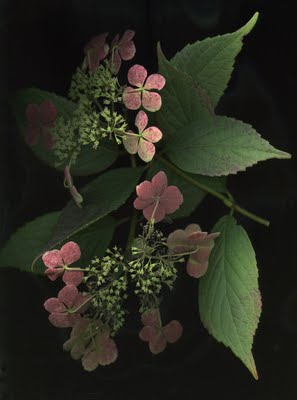
Today is my real birthday. I was born on August 31, 1492 in the Anchorena Hospital in Buenos Aires. I am not sure I believe my mother’s story about my father forgetting to register and doing it so on April 18, 1943. My Argentine birth certificate lists the latter as my real birthday and the only “proof” of my real one is the date on my Mappin & Webb birth spoon. My official birthday is most practical because it makes it easy to remember Rosemary’s. Her birthday is on April 19.
A week ago Rosemary left for Ottawa on her way to Maitland to a wedding of her nephew. She was accompanied by our daughter Hilary who was a great help in pushing Rosemary around in her wheel chair. I missed Rosemary but I save lots of money as instead of buying food I decided to empty the refrigerator. She and Hilary returned today.
The little girls, Lauren and Rebecca, were deposited at 11am today. All I could offer them for lunch is one of my favourite meals. It featured fried tomatoes that are almost burned. The sugar content of the tomatoes causes them to go through drastic change in taste which is peculiarly lovely. You scrape the tomatoes off the pan, wait for the pan to cool a bit and then you scramble eggs. The eggs turn into a beautiful ochre. Both Rebecca and Lauren thought the meal was delicious. For a drink I put Ale’s heavy syrupy apricots (from her Lillooet garden) into the blender with ice and lemon juice. It was a feast!
Because of the suitcases and Rosemary’s wheel chair I could not take the girls to pick up Rosemary and Hilary at the airport. We returned and Toby was very glad to see her mistress. We went to Nando’s for my birthday dinner (very hot piri-piri wings). We returned and Hilary unpacked Rosemary’s suitcase while I arranged a light outside so that Rebecca and I could take our picture (Rebecca did the taking by squeezing the bulb). The picture is going to illustrate our two essays (Getting Children Interested in Hostas and Gardening) for the fall issue of the American Hosta Society’s Hosta Journal.
I took Lauren, Rebecca and Hilary home. When I returned Rosemary was pretty well asleep. I though of how I could illustrate my birthday blog. My birthday is always primarily a memory of my birthdays in our Buenos Aires garden. August 31st was preceded or followed by a great storm called La Tormenta de Santa Rosa de Lima (St Rose of Lima Storm) as her day falls on August 30 and traditionally there is lots of rain with wind, thunder and lightning. My birthday was always held in the garden with a piñata and the game of putting the tale on the donkey. That garden is imbedded in my memory as are the plants that grow in the Southern Hemisphere like the oleander, iris, wisteria and my very favourite persimmon tree. And, of course, there are the hortensias or hydrangeas. We have many more varieties and species in our Vancouver garden than we did in Buenos Aires. But I still see hydrangeas as companions of my past. Most at this stage of the summer are in decline. The hydrangea here is Hydrangea serrata ‘Blue Bird’. As the flowers fade they change into beautiful fallish colours. It is a lace cap. Most people think that hydrangeas come in two forms, mop heads and lace caps. There is a third that is conical. One of them, Hydrangea paniculata ‘Unique’ is at its prime right now. It is brilliantly white and is full of pollen that has a very strong honey fragrance.
The regularity of my hydrangeas make them good companions in a garden that is past its prime (very much like the resident gardener). And like the resident gardener they are still able to surprise even at this late summer date of August 31.
Best of all Rosemary is back.
Abraham Rogatnick's Manifesto For Staying Put
Sunday, August 30, 2009
Five weeks before Abraham Rogatnick died he wrote a précis on his views related to the proposed moving of the VAG and met with Vision Vancouver Councillor Heather Deal. She read it and indicated she would wait and see to Rogatnick's disappointment.
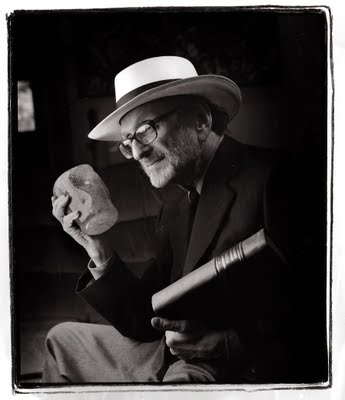
Re: Proposed relocation and expansion of the Vancouver Art Gallery:
For the benefit of the city and for the good of the Gallery, the institution should remain at its present site and should plan for a sensible, economic and feasible program of expansions to be carried out in a series of reasonable phases to take place over a number of decades.
1. The location bounded by Georgia, Robson, Hornby and Howe Streets is the most prestigious and fortuitous site for Vancouver’s major public art gallery.
2. The Gallery’s location is the most advantageous point in the City as a proud symbol of Vancouver’s cultural image both for its citizens and for visitors from around the world.
3. The building is a precious icon both for its aesthetic interest and for the fact that it represents some of the finest work of two of British Columbia’s finest architects: Francis Rattenbury and Arthur Erickson. Its use as a centre for fine art is eminently fitting, considering the historic contribution these architects have made to the development of the artistic culture of the Province.
4. The basic masterful adaptation of the building conceived by Arthur Erickson works exceedingly well functionally and aesthetically as a major art gallery.
5. For a skillful architect the ample spaces available for expansion under the Georgia Street lawn as well as the space between the main building and the annex offer a great variety of possibilities for expansion to satisfy the Gallery’s needs for several decades to come. Please note the recent brilliant additions to world famous galleries housed in heritage buildings such as the Louvre in Paris, the Art Institute of Chicago, and the Art Gallery of Ontario, to name just three. Many more could be cited.
6. Since the major structures now housing the VAG are intact and in good condition, the cost of expansion would be lower that starting from scratch with a monumental building at another location.
7. My discussions with some of our most distinguished architects and urbanists (Jim Cheng, Bruno Freschi, Bing Thom, Joe Wai and the regrettably late Peter Oberlander, among others) have corroborated all the opinions I have outlined above.
The Gallery’s proposal to occupy the entire precious city-owned sit abutting the Queen Elizabeth Theatre and Playhouse represents a callous indifference to the ongoing (remarkable and salubrious) urban development and cultural growth of the city. That site is urgently needed for several crucial urban requirements crying out for attention at the end of Robson Street, such as several layers of underground parking to accommodate the competition for parking for thousands of theatre-goers and sports fans crowding the large scale events nearby. If a theatre and concert hall (a la Chan Centre) were to be built at the Dunsmuir end of the site (highly appropriate to augment the developing theatre district of the area) enough space would remain for a vibrant public square containing restaurants , coffee shops and other amenities for the use of the public before and after attending nearby events. Not to mention ordinary daytime use for the staffs of surrounding institutions, office buildings and library users.
Besides being a stereotypical “concerned citizen” in love with Vancouver I believe I have some valid credentials as an advocate in the world of art, architecture and urban development. I beg your indulgence.
B.A. (cum laude), Harvard College. M.Arch., Harvard Graduate School of Design. Honorary Doctorate, Emily Carr U.
Member (retired) of the Architectural Institute of British Columbia (including honorary recognition). Fellow of the Royal Architectural Institute of Canada.
Several decades as U.B.C. professor of history of architecture and design, also teaching a special course in urban history. Visiting lecturer at the University of Victoria, Simon Fraser University, Istituto di Architettura (Venice), Waseda University (Tokyo), Vancouver Art Gallery, Montreal Gallery of Fine Art, Art Gallery of Ontario, International University of Art (Venice-Florence) the Canadian Embassy in Rome and the staff of the Vancouver Planning Department.
Life-long study of the functioning of the great art galleries of the world, cofounder of one the earliest commercial galleries devoted to contemporary art in Canada (mentioned in more than forty books on Canadian art). Advisor and consultant to various art galleries in Canada, including supervising the compilation of the complex program for the National Gallery (used by Moshe Safdie as a basis for his design of the present building). Besides acting as architectural advisor to National Gallery Director Jean Sutherland Boggs, I continued to advise her when she became Director of the Philadelphia Museum of Art and when she was appointed by Prime Minister Trudeau to head the Crown Corporation charged with overseeing construction of the National Gallery and the National Museum of Man. I was hired to create the guidelines for Concord Pacific’s program of public art (published as a book by the company). I also carried out a similar project for the District of North Vancouver (also published in book form).
I spent 1971-72 as Interim Director of the Vancouver Art Gallery and advised on the move from its old quarters on Georgia Street to the refurbished Court House.
I have written extensively on art, architecture, and urban development for Canadian and international publications in the U.S., Great Britain, Italy and German Public Radio.
A Failure Of Our Reactive Media
Saturday, August 29, 2009
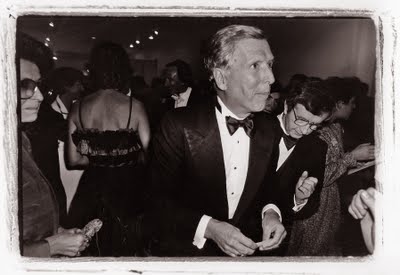
I took the photograph above of architect Arthur Erickson as he entered "his" VAG when it was inaugurated in 1983.
For two months I taught two photography classes at Focal Point on West 10th avenue in June and July. My classes were from 2 to 5 and from 7 to 10. What was I going to do for those two hours between classes? My friend Abraham Rogatnick lived around the corner so I suggested we meet somewhere to eat something light and chat. Abraham suggested a place oddly called T Room Bakery and Kitchenware on 4445 West 10th Avenue.
Abraham would walk with his sturdy cane the one and a half blocks (a steep climb coming) and we met around 5:10. We soon found out that the T Room had a garden in the back with chairs and tables with awnings. The female Chinese owner had lived for man years I Brazil and not only spoke Portuguese but excellent Spanish. We soon felt at home and Abraham had a fondness for the flaky palmiers (the dark ones were his choice) while I enjoyed the eggplant sandwiches and the delicious and strong Kemba tea from Africa.
We would chat until the T Room would close at 6 and we would slowly walk back to Abraham’s house where we would continue with our conversation until around 6:45 when I would head for my class.
In one of our meetings Abraham brought architect Bruno Freschi whom I had never had had the fortune to meet. In that meeting and in several ones after Abraham told me, “I would like to get this off my chest and go public before I die." I did not know then that he knew he was going to die soon. He wasn’t kidding. I told him I would see what I could do.
Abraham believed that our VAG in its present location was at an ideal location. It is the city’s centre. It is in the back steps that political manifestations are held. Robson Square is there even in its reduced form and now covered in tarps and with work that few know what its purpose might be.
Abraham taught art history and history of architecture at UBC for many years. Some of his students include Bruno Freschi, Henry Hawthorn, Bing Thom, Paul Merrick, and many more including one odd one, Glen Clark! With his background and his two Harvard degrees (one in architecture) Abraham had the credentials for sound opinions. It was his opinion that from the middle ages art galleries and centres of learning were always placed in the centre of the city. He cited the Louvre, the National Gallery in Washington DC and the Metropolitan in New York. “It would be cuckoo to move a gallery from that centre,” he said to me, gesticulating and using that favourite word of his, cuckoo. He explained how E.M. Pei had gone underground at the Louvre and beautifully combined the old building that was the old National Gallery with a modern extension in concrete that was almost seamless in its transition from marble to the concrete. Since I have been to those two museums and to the Metropolitan I was able to agree with him and to further agree that to dig down on the Georgia Street side of the gallery was a good idea. “There is lots of room down there. We don’t have to have a Pei glass pyramid there but it would be a marvelous opportunity to get rid of that awful rock fountain.
That rock fountain was Arthur Erickson’s bête noire. Erickson hated it (I do too!) and was never able to convince anybody about it. Last year I asked him about the equally ugly Olympic countdown clock. His one word was, “Awful.” Abraham told me that he only heard Erickson swear once since he had met the man back in 1955.
Abraham said that the two proposed sites for the VAG were equally cuckoo. The whole city block that was the old Greyhound Station was too far from the centre and too close to the theatre district in his opinion. Abraham wanted to install West End type housing (families without children as no schools are near that area) and a large park and shops. He had even done some sketches based on topography charts he had obtained from Bing Thom. The other site at the Plaza of Nations has land that is still settling. As a matter of fact ex-mayor Sam Sullivan’s office is there and he has noted how his office has been sinking. Bruno Freschi, our Expo 86 architect confirms the land is unsuitable.
I decided to do some research and talked to Max Wyman and architect Henry Hawthorn. In what seems to have been separate planning meetings as Wyman and Hawthorn were not in the same room plans were discussed which included the incorporation of at least two floors of the Cesar Pelli Simpson Sears building (ex-Eaton’s) and its linking to the VAG by either underground escalators or elevated walkways.
“Surely, these would be cheaper solutions to the alternative of starting from scratch somewhere else,” Abraham told me with a luxury of detail that has no place in this blog.
I made this list:
1. CBC, On The Coast
2. Studio 4, Fanny Kiefer Show
3. Bill Good Radio Program
4. David Beers at the Tyee
5. The Editor-and-chief of the Vancouver Sun
6. Two columnists, Fiona Morrow and Tom Hawthorn at the Globe.
7. Paul Grant the arts reporter at the CBC was retiring at this time so he was never an option.
And this was the result of my efforts:
1. The CBC was a maybe and then I heard no more.
2. Studio 4 told me that the VAG was too Vancouver and not enough BC.
3. Bill Good never responded.
4. David Beers of the Tyee did respond to tell me he would keep it as an option when the VAG did become an issue.
5. The Editor-in-Chief responded to say she had forwarded my communication to the Editorial Page Editor.
6. There was no response from the Globe writers.
It soon became evident to me that our conventional media as it is today in Vancouver is a reactive media. Few will take the chance on being first in blowing the whistle to a future issue or problem.
For a while I suspected that Abraham's stance on the VAG was to defend the legacy of his friend Arthur Erickson and that of Francis Rattenbury. "No, no, no!" he angrily told me. "It is about its location. It is in the middle of the city. That is where it is and should be. I would be a folly to move it."
As Abraham got worse I understood that the TV or radio was no longer an option. Ex counselor Gordon Price and Max Wyman both suggested that an OpEd at the Vancouver Sun would be the most likely vehicle for Abraham Rogatnick’s proposal. I told Abraham that the best possibility of success was to write the OpEd and submit it. I was ready to take dictation on a computer. But Abraham’s health deteriorated quickly and nothing was ever written down.
I wonder if there is anybody in Vancouver willing to pick up the fallen baton.
Abraham Jedidiah Rogatnick Switches Off - 1923 - 2009
Friday, August 28, 2009

The web can make you feel smart. Sometimes in its very shortcomings it can help you learn.
A few days ago Abraham Rogatnick (he was in hospital and not well) and I were discussing a favourite architect of his, the Venetian Andrea Palladio (1508-1580). I had brought him a book (Rosemary’s) called All-Italy – The Book Of Everything Italian. I showed him the page that featured Palladio. It was a majestic photograph of Palladio’s church Il Redentore on the bank of the Grand Canal in Venice. After Abraham looked at the picture he began to trace his fingers on the façade, ever so gently, as he carefully explained (it took about 30 minutes) why this church is one of Palladio’s most famous buildings, “He hid the buttresses on the side, like this and you almost do not notice them.”
I returned the next day having done my homework by looking up Palladio on the internet. “Abraham,” I asked him, “does the name Andrea di Pietro della Gondola ring a bell?” “That’s a well known Venetian name, but that particular one does not ring a bell at all.” I triumphantly felt I had finally caught Abraham at something I knew that he didn’t know. “Abraham, that’s Palladio’s real name.” Abraham looked at me and smiled. He then said, “That may have been his real name but that was not the name that defined him. The name Palladio was given by a patron. It comes from Pallas Athena the goddess of wisdom. His patron thought your Andrea della Gondola was a wise man and so gave him, my Palladio his nickname.” I felt a tad ashamed and suddenly a bit smarter.
Months before, Abraham had explained to me how Palladio had influenced Francis Rattenbury in his two most famous BC structures, the current Vancouver Art Gallery and our House of Legislature. It seems that Palladio’s country homes for the Italian rich had a central structure and two wings. One of the wings would have the chickens and the goats and the other perhaps the kitchen. With a twinkle in his eyes and without telling me more Abraham left me wondering and to figure out for myself which side of our legislature housed the chickens and the goats and which the kitchen.
Yesterday Thursday was my last day at school. My final lesson with Abraham began when I called him at four, “Bring me a Globe if you can find one at this time of the day.” On my way to the hospital I bought the last copy of the Globe at the 12& Cambie Safeway. Before I even gave the Globe to Abraham I got rid of the business section and the life section. Abraham had no use for them. As we chatted for an hour I had no way of knowing that the last Safeway Globe would be Abraham’s last Globe.
Death to Abraham as he told me, “It is as easy as the light switch on that wall. One moment it’s on, the next it’s off.”
This morning I got a call from Lynn Zanatta and Sam Sullivan that Abraham was not responsive. When I got there, the man on the bed was no longer the Abraham I had loved and known. It was the light switch in an almost off position. I spied a tear under his left eye. It would have to make do for the tears I have not been able to shed since I learned that Abraham died today in the afternoon.
I picked up Rebecca (my 12-year-old granddaughter) at noon and told her that Abraham was going to die today or tomorrow. “Do you think I should go to see him?” she asked me. I wasn’t sure and did not answer. When I got the call from Lynn that Abraham had died I told Rebecca that it was best that she remember him when she saw him last, holding court from his sofa some weeks ago in the presence of architect Bruno Freschi and poet George Bowering.
Last year when I took Rebecca to visit Sam Sullivan at his office (he was still the mayor) we were joined by Abraham who was going to give Rebecca (naturally!) an explanation on Art Deco architecture. Rebecca looked at Abraham and said, “It occurs to me that you and Obama have something in common. You both hold a degree from Harvard.” Abraham looked at Rebecca and with that endearingly cocky attitude of someone who is very sure of himself loudly countered, “We are different, too. He has one Harvard degree but I have two.”

Rebecca and I did celebrate Abraham’s life in our own way. We walked in the garden. I tried not to look at the English Roses. I had taken some to the hospital. Abraham had particularly liked Rosa 'Abraham Darby'. Then Rebecca dictated to me the essay on how to get children to garden for the American Hosta Society Journal. We went to town and had Indian food at the India Gate on Robson. From there we enjoyed a wonderful, cerebral and melancholy film called Moon. Without having to talk, both of us were aware that having known Abraham has been good not only for our hearts but for our brains. It was that fine balance, between brain and heart that made Abraham Jedidiah Rogatnick the unique person he was.
The Last Thursday For The Thursday Girl
Thursday, August 27, 2009

There is something quite nasty called a wit of omission. Someone will come up to you and tell you, “I could say this but I am not going to.” You are left not knowing what you are missing. A bit of this will transpire in today’s blog. I will tell you that I took some very interesting photographs but that I really cannot show them. But I did take a few with the express purpose of placing them here today.
Because I am leaving my studio at the end of September I sent an e-mail to the Jo-Ann, The Thursday Girl (we only shoot on Thursdays) telling her that time was short to take our pictures in the roof of my studio which is on the corner of Robson and Granville. The view from the roof is interesting because most all of the buildings that surround it are taller. Access to the roof is through a narrow outside fire escape type metal ladder in which you hope you are not afraid of heights.
The idea was to take some nude photographs on a very hot and sunny day to imitate in our own Vancouver way the roof nudes that Edward Weston took of Tina Modotti in Mexico City. These are the pictures I cannot show you here. We took the photographs today and it was indeed a hot day.

Before we left I asked Jo-Ann if the Thursday picture sessions would continue. It seems that her day off will no longer be on Thursdays but the "Thursdays" will continue. This self portrait that Jo-Ann took of us represents the end of an era for me. Henceforth I will shoot at home, in the garden or somewhere else.
Paul Anka, Peggy Lee, Diana & John Wayne
Wednesday, August 26, 2009
I'm so young and you're so old
This, my darling, I've been told
I don't care just what they say
'Cause forever I will pray
You and I will be as free
As the birds up in the trees
Oh, please stay by me, Diana
Paul Anka, 1957
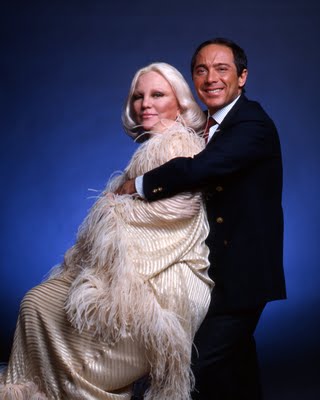
In 1982 I landed the lucrative job of taking the publicity stills for the Paul Anka Show produced by the CBC and performed in the cavernous Studio 40 of the corporation’s then pretty snazzy Paul Merrick building on Hamilton and Georgia.
If someone had told me this back in 1957 I would not only have been incredulous but I would have uttered, uncharacteristicaly, several four-letter words. Uncharacteristically, as in 1957 I was a fairly saintly and correct boy in a Catholic boarding school in Texas.
For a short while our very large neo-Gothic dorm (50-plus boys in bunk beds) was invaded by a love struck boy who was assigned an upper bunk next to mine. I believe he must have been sent to the boarding school by his girlfriend’s parents who must have given the boy’s parents a grim alternative, send him away from their girl to the Catholic boarding school or a shotgun.
Such is my effort to forget the whole incident that in spite of my extremely good memory I cannot remember the boy’s name or face. I can remember he did not cease to talk about her and that her name was Diana. He insisted on playing a song, Diana, over and over, loud on the his 45RPM record player. Diana was my introduction and my first intimation of an intense dislike for a young Canadian called Paul Anka who was the composer. How was I to know then that Anka and Canada would one day be part of my life?
Somewhere below I will make the connection between Anka and Frank Sinatra. I loved Frank Sinatra’s films but I have always been selective about the song of his I like. Most of the ones I like are the ones he sang with the Nelson Riddle Orchestra. I absolutely hate the very big band Sinatra songs with him holding a microphone. For me he was an early version of the Las Vegas I have avoided most of my life. I need not add, but I will, that I cannot stand New York, New York and My Way.
There is no room here for my opinion (it would be a long venomous diatribe) on Paul Anka’s (You’re) Having My Baby.
So in 1982 for a whole spring I shot stills of Anka’s CBC variety show almost every day. He would open most shows with New York, New York (I will never know why he chose this song since he did not write the lyrics or the music). I became de-sensitized to the song but when Anka would sing Diana every once in a while I became a staunch Catholic all over again, believing, without a doubt, in the existence of hell.
Anka had clout and he was able to get many American celebrities to come to his show as guests. Two are permanently inscribed in my memory. One of them was a 21-year-old Wayne Gretzky the other was a permanently high/low (but mostly low on downers) Peggy Lee who had a special assistant who held her purse and handed her pills every time she asked for them. Lee’s volume was so low that the CBC sound engineers must have been having babies while adjusting the frequency response of their recording equipment.
I tolerated Peggy Lee (I am an Ella Fitzgerald and Annie Ross fan) as a singer but unfortunately my taste for her had been ruined by the parents of my friend Robert Hijar, back in the Mexico City of 1962. His parents were operatives of the CIA and they had a back garden little coach house-like structure where they kept their massive and costly reel-to-reel tape recorders. In their leisure time (how busy would CIA operatives have been in a Mexico run by the institutional party the PRI?). Robert and I listened to 60s West Coast Jazz (Mulligan, Getz, Bud Shank) the Modern Jazz Quartet, Miles Davis and Dave Brubeck. He would occasionally make me listen to his parent’s collection of Peggy Lee and Henry Mancini. If any who read this have ever seen the film Hatari (Howard Hawks, 1962) with an out-of-his-element in deepest Africa John Wayne (which proves how genetically apart a horse is from a zebra) you will understand why I am not going to lambaste Mancini’s odious Baby Elephant Walk. There was no meat to this film. Elsa Martinelli was all beautifu bones, but bones, nonetheless.
David Charvet - A Sensitive & Kind Young Man
Tuesday, August 25, 2009
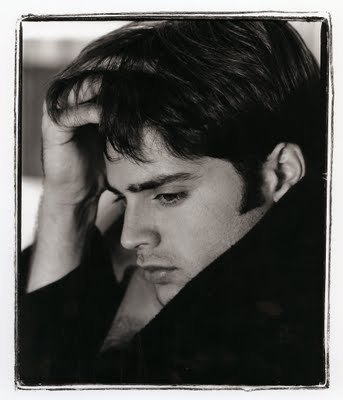
When I received a call from Entertainment Weekly Magazine in June 1995 I had no idea what the magazine was about ( I soon learned they paid very well) and I had no idea who the young man, David Charvet was that I was being assigned to photograph. I heard the word Baywatch but since I have never watched much TV the program did not ring a bell.
I spent a day with the young man who surprised me with kindness and sensitivity and rapidly agreed with me when I told him his best feature was his profile. I photographed him in colour and in b+w. I like the b+ws better.


Because I do not allow comments on this blog nor do I have a counter or any way of gauging its popularity my guess is that the few that might read it must be men as I post lots of photographs of women. I hope that these portraits of the French born actor will please the few women who might take a glance in this direction.
Neck Folds & Elegance At The Bar
Monday, August 24, 2009

If any of my photography students were to show me a photograph like this one I would crucify them. I teach my students to avoid neck folds and I specifically ask them to crop pictures when they take them and never later. In the case of the photograph here my crop is justified for two reasons. For one it is only a very small section of a negative that is a most beautiful full nude. No nudes in this blog as you might know. A few slip in, now and then. The second reason is that I would like to keep this mystery woman a mystery.
This mystery woman invited me to attend a performance of Ballet BC some years back. It was a sort of business date as both of us were working on something having to do with ballet. Before the dance function we met for drinks at the bar of the Hotel Vancouver. I expected her to dress elegantly so I wore a suit and tie. She was about 30 years younger than I was. There was absolutely no hanky panky even remotely considered. If anything, at the time the woman (who was the same age as my older daughter) was having precisely the same problems with her boyfriend as my daughter was having. I have a feeling she saw me as a much older man than the younger man she made me feel like I thought I was.
Looking back at that evening of drinks and dance and being accompanied by a beautiful and graceful ex-ballerina I consider myself most lucky. In that very same bar I have had drinks with many authors including Isabel Allende and Vancouver notables like Harvey Southam. It was a regular watering hole for Celia Duthie. We often shared a clubhouse sandwich there.

But it was the mystery woman for drinks (I had a Tio Pepe, she a martini) that has provided me with such a lasting, exciting and fond remembrance of the classy kind of stuff that seems to be fading from my very own existence. When I think of taking my wife to a good restaurant I am not sure that her, “Alex, I prefer your cooking. Let's stay home,” is all that romantic. I will have to borrow from that past and suggest that we go to the ballet and have a drink at the Hotel Vancouver. When this happens I will feel like a million dollars all over again. Or as it was defined to me once, a lady is a woman who makes a man feel like a gentleman.
The Horror Of Birth - The Philosopher Opines
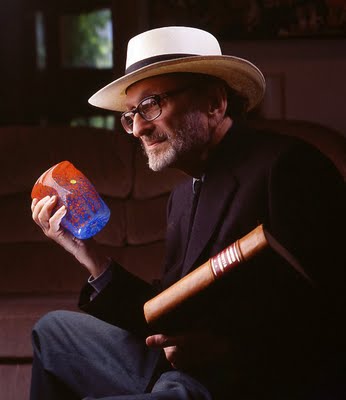
I don't believe in God, but I miss Him. That's what I say when the question is put. I asked my brother, who has taught philosophy at Oxford, Geneva and the Sorbonne, what he thought of such a statement, without revealing that it was my own. He replied with a single word: 'Soppy.'
nothing to be frightened of, Julian Barnes
The euphoria of thinking he was well again led my friend Abraham to over extend his confidence. He fell in his kitchen on Sunday morning. At emergency they confirmed his suspicion that he had broken his hip. The rosy news was that the break was not a clean one. A chip showed up in the X-ray. This would mean that an operation is not necessary. What is necessary is a four week confinement in bed. For a man of energy this will not be easy.
So we spoke of death and Abraham the philosopher pointed out to me that death is certainly nothing to be afraid of. He said, “I can reach over to the wall and turn off the switch on the wall. That’s death. What is fearful is birth. Consider being nice and warm surrounded by amniotic fluid in a nice dark place with not a care in the world. Suddenly it all ends. You are ejected from it and emerge in a noisy environment full of bright lights. To make it all worse you are spanked and you begin to cry.” Abraham looked at me and almost shouted, “That is something to fear!” With a smile on his face he told me of a doctor he once met who made being born a quiet and low light affair. These newborns were not spanked and most did not cry. “He was a smart doctor. The rest are just plain dumb.”
I was not about to argue or disagree with a man who is not well. Isn’t the slap supposed to force the baby to breathe? Isn’t breathing life?
I have my own simplistic theories. One of them is based on the human penchant, or obsession, with symmetry. We observe we are born with nothing and that we die, leaving with nothing. We like to see the symmetry of birth and death. I have gone a bit further and noticed that Alzheimer’s is sort of a reverse birth. We are born with no consciousness that we are aware of (or at least of a consciousness we do not remember we had) and at the end of a life, when Alzheimer’s sets in we fade away in a similar manner. There are obvious differences. Before we are born there are those nine months. Alzheimer’s can take years and bad cases affect families terribly and tax our government care centres. Alzheimer’s could be nature’s way of showing us that symmetry is a common reality.
But for every case of symmetry in nature there are examples of asymmetry. Our faces, our heart’s placement, they are asymmetrical.
Abraham commented to the resident orthopedic surgeon that in his case he had an active and alert mind that could not convince the body to let go. The orthopedic surgeon gently countered that, “Here in emergency that is countered by another one, that of the good body that cannot let go of the slipping mind.” I thought of those two as an odd example of symmetry, of sorts.
I also thought that if Abraham is going to be confined for four more weeks I am going to learn a lot more about death and birth, in no particular order.
Alexandra's Gifts
Sunday, August 23, 2009
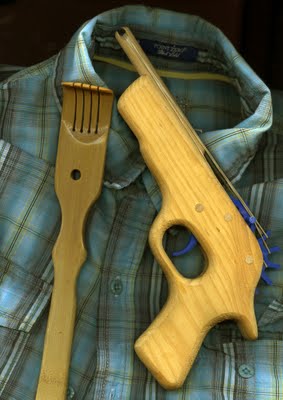
I may have been 13 when I went to a tlapalería (a type of Mexican hardware store that is more basic and cheaper) on Avenida Ejército Nacional in Mexico City and bought my mother a pair of electrical pliers for her birthday. In my pocket I had the right sum of money. Everything else in the store, worth having (or giving), was beyond my budget. I never asked my mother if she liked her electrical pliers (the rubber grips were tested to withstand up to 23,000 volts!). And the pliers are still in our kitchen drawer although the thick insulating grips became so cracked that I had to remove them and throw them away. It is my guess that this talent for giving unexpected, and sometimes useless gifts, is a talent that my daughter Alexandra has inherited.
Ten years ago she gave me a tan polyester vest with some pockets (thankfully it was not one of those photographer’s vests) which I immediately buried in the darker confines of my closet. Just a bit curious I decided to try it on one day, many months later. It was comfortable. It washed easily and it kept my body warm without much weight or fuss. And it did not look like "one of those photographer’s vests!" I found other uses for it. It was great for airline travel as I could keep all my documents and tickets in the inside pockets. After repeated washings, seams have unraveled and I have had it repaired many times. I will have it repaired until it becomes impossible to do so any longer. I love my vest. Besides, Ale gave it to me.
Last night, in the middle of the night, I had an itch in my back and I could not reach it with my left arm. My left arm is no longer as flexible as it once was since I broke my elbow two years ago. I got up and went to the guest bathroom downstairs where I store Ale’s back scratcher. The relief was instant and most pleasant. By the scratcher I keep Ale’s rubber band gun. She gave it to me a few Christmases ago. I terrorized Rebecca and Lauren with it until Lauren learned to use it and she now terrorizes Rebecca and me. Notice that it is a repeater. It is a five-shot.
The loud sports shirt is Ale’s latest surprise gift. She knows I like the clothing of Mark’s Work Warehouse so she bought it there. The shirt was a tad too big so I put it into the washer with hot water and over dried it a few times. It almost fits. Putting it on somehow changes my perception of my world, what I am and who I am. My world is a predictable and logical one. I have worn the same type of turtle shell frame glasses since I was 30 and most of my shirts have button down collars. I dress conservatively. I am a creature of routine.

Every once in a while I spot men in the bus who are in their 60s (I am in my 60s) and they have a carefully constructed duck cut hair cut. They wear pointy shoes, black leather jackets and must look like older versions of themselves 40 years before. They look silly.
I would have never bought this fluorescent green shirt in a million years. I would have thought that I look silly and much too young.
My daughter Ale has seen in me something that I never suspected was part of me. Could I be just a bit more daring than I think I am? She does this gift-giving with a loose cannon irregularity. I love her for it and I must admit I now like my shirt. I cannot wait for her next shot across the bow.
Octavian's Marble
Saturday, August 22, 2009

I have been visiting retired architect Abraham Rogatnick daily for the last two weeks. My reward has been an increasing knowledge of art history, architecture and wonderful stories of our city’s leading architects. It seems that Rogatnick, who is now 86 taught many of them. Today, as an example he was telling me of three young students of his who showed promise. These were Paul Merrick, Henry Hawthorne and Bruno Freschi. It was like being in that classroom with Rogatnick and peering into the young faces of three men who have left their stamp on our city.
This is why architects have been on my mind. I looked for the picture of Dr. Rhodri Windsor-Liscombe who is a professor and head of UBC’s Art History, Visual Art Theory Department. In 2005 I photographed Dr. Windsor-Liscombe in one of his favourite spots involving Vancouver architecture. He loved the look of the post office boxes of our main post office on Georgia Street.
Because this is a Federal building I was only able to shoot 5 exposures before we were almost man-handled by security guards who threw us out. In fact I had a just as scary situation when I was attempting to shoot with my panoramic camera inside of the CN Train Station. Tourists can happily snap with their digital cameras but if you show up with something that does not fit that profile you are considered to be a terrorist casing the joint.
I have always been fascinated by our main post office on Georgia across the street from the CBC and opposite the Vancouver Playhouse and the Queen Elizabeth Theatre. The main post office is supposed to be one of the largest welded steel structures in the world. Since my knowledge of architecture is limited (in spite of Professor Rogatnick’s efforts to change that) I would assert that the building inaugurated September 14, 1958 is a Vancouver salute by architect Bill Leithead to Russian/Rumanian heroic architecture. It certainly is not a wall of glass suspended from a steel interior like some of the office buildings of Vancouver. It is a building that would perhaps be the safest place on earth during an atomic holocaust, particularly the mail transfer tunnel that was built to link the post office to the CPR Train Station at the foot of Seymour. The post office was too late with the tunnel as airmail was the norm. And they got another one wrong as the helipad on the roof has never been used.
For me what makes this building so special is its monumentality. You go in and if you happen to look up you will note the very high ceiling. High ceilings seem to be verboten now as all efforts have been made by some misguided modernist (not in the architectural sense but meaning someone trying to “improve” on the past) to hide it. I like the solidity of a building in a city where so many of the homes seem to be made of cardboard. I was told when I came to Vancouver in 1975 that it was not cardboard but something called gyprock. I also see a comforting familiarity with the buildings of my city of birth, Buenos Aires where Juan Domingo Perón wanted to make sure people remembered him by the endurance of his buildings.
I sometimes abuse my commercial plate and park our car on the back alley next to Holy Rosary Cathedral. From there Rosemary and I (and sometimes Rebecca, too) walk to theatrical performances at the Playhouse or for Ballet BC or Vancouver Opera shows at the Queen Elizabeth Theatre. It is pleasant to pass, note, and touch the smooth surface of our post office’s granite walls. Augustus and his Romans liked marble, I like marble. There is very little of it in Vancouver. At least our post office has polished granite.
And unless we are told exactly what is going to happen to our Main Post Office it would seem that our future holds even less marble and granite.
Hydrangea aspera, Shark Skin & Hostas
Friday, August 21, 2009
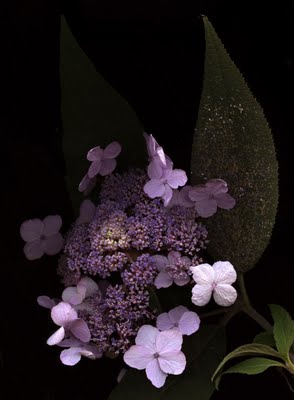
Rebecca and I have been commissioned to write an essay for the Hosta Journal which is a beautiful thick and glossy publication of the American Hosta Society. I have written for it before and I have even had a few front coversm(below left) and back covers, too. This time around I am extremely excited as our theme is how to get children into gardening and hostas. What is unusual is that we are not going to write a joint essay but two separate ones.
In 1986 when Rosemary and I (and our two daughters Ale and Hilary ) moved to our present home on a corner lot we were ignorant gardeners (Rosemary knew a bit more) faced with mature garden with large shrubs and trees. There was a lot of shade. I consulted garden books and they all mentioned ferns and a strange plant I had never heard of called a hosta. My interest in gardening began with this faithful cast iron plant that requires little tender loving care.
My interest in this plant that originally came from Japan, Korea and China increased to the point that I became a member of the American Hosta Society and traveled to my first national convention in Columbus, Ohio in 1992. I was befriended by all the host gurus like Alex Summers, Mildred Seaver and George Schmid. These gurus and many others were involved in the selection and discovery of many of the plants in my garden. The names of my hostas suddenly had faces attached to them. To this day every hosta in our garden has a face. I know why specific cultivars have the name they have. Many are inside jokes.
In 2004 when Rebecca was 6, Rosemary and I used the excuse of going to the American Hosta Society Convention in Washington DC to take her along with us. Rebecca met Alex Summers, Mildred Seaver and George Schmid. She connected with the first two and in one bus trip to see a garden she sat with Alex Summers (the founder of the AHS) and they chatted at length. I have no idea what it was they talked about.
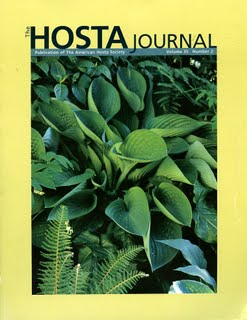
At the convention Rebecca studied all the leaf specimens and she inspected the hostas in the show gardens. She went nuts over the then brand new and extremely rare Hosta ‘Blue Mouse Ears’. In my suitcase home I brought a tiny hosta, ‘Cat’s Eye’ which I divided. One was for me the other for Rebbeca.
Taking the DC Metro to the Mall (we were headed to the National Gallery) Rebecca spotted a woman who had an AHS convention pin on her dress. Rebecca casually went up to her and said, “My grandfather has Hosta ‘June’." The woman retorted with, “I have ‘Emily Dickinson’." Rebecca fired back with Hosta ‘Marilyn’ and Hosta ‘Janet’. Both kept at it until they ran out of women’s names. It was only then that I found out that Rebecca had memorized most of the names of the hostas in our garden in Vancouver.
Since then Rebecca and I have had a parallel growth in our interest in plants. Hers has been more accelerated and she has told me flatly that she does not want to write an article on how to get children to like hostas, “I would rather write about my interest in roses.”
I had to explain to Rebecca how the hosta became, for both of us, our entry into gardening and thus a hosta is a good plant for children to learn about gardening. As they become confident in their cultivation they can tackle more difficult plants. I have also shown Rebecca that come mid August when the roses wane and Rosemary’s perennials are in decline, it is the hosta that comes into its own. I showed her how some of the yellow hostas bleach out into wonderful gold colours and how the fragrance of Hosta plantaginea with its fluorescent white flower can almost compete with the fragrance of an old rose or a Magnolia grandiflora.

Rebecca will tell you that the flower featured here is from a Hydrangea aspera. There are many variations of this plant that originated in Nepal. I have three of them. This one we call the “straight aspera” although after consulting Hydrangeas – A Gardener’s Guide by Toni Lawson-Hall and Brian Rothera I suspect it is probably Hydrangea aspera ‘Macrophylla’. While Rebecca has never touched a skark’s skin ( I did in a Mexican fish market) she will tell you that aspera comes from Latin and it means rough textured and with your eyes closed touching an aspera is exactly like touching a shark. In the scan here you can see that the rough skin acts as ‘fly paper’ to the flower’s pollen.
Rebecca and I are going to walk in the garden on Wednesday before we write our essays. She will note that the only competition that the hostas have right now are from the equally faithful and easy to grow hydrangeas.
Los Pensamientos De Lauren
Thursday, August 20, 2009
Pensamiento
Planta herbácea anual, de la familia de las Violáceas, con muchos ramos delgados, hojas sentadas, oblongas, festoneadas y con estípulas grandes, flores en largos pedúnculos y con cinco pétalos redondeados, de tres colores, que varían del blanco al rojo negruzco, pero generalmente amarillos con una mancha central purpúrea los dos superiores, pajizos los de en medio y morado oscuro aterciopelado el inferior, y fruto seco capsular con muchas semillas. Es planta de jardín, común en España.
Real Academia Española

Few people unless they are serious gardeners understand that the common pansy is in the same family as the just as common violet. I need not translate that or the extremely detailed description of the pansy from my on-line dictionary of the Real Academia Española.
When you have two granddaughters and when one of them is younger (Rebecca is 12, Lauren 7) you can get away with getting a present for one without getting on for the other when the young one is very young. So Rebecca has been getting roses, hostas and the odd rhododendron from me for her backyard garden (her plants are all in pots) without any equivalents for Lauren. But Lauren began to notice and I felt guilty. I couldn’t give her roses as she was much too young to take care of them. Roses can be fussy. Last year I gave her a pot of winter pansies. She was delighted with her gift. Every time I go to inspect Rebecca’s garden, Lauren points out at the excellent condition (they are kill proof!) of her pansies. She also has Hosta ‘Peanut’. I gave her sister one of these small hostas, too.
I have observed that while Rebecca has an interest in roses and other plants of my garden, Lauren notices plants, too. She pointed at two little box hedges at our front gate and asked, “Why is one in good shape and the other one in not so good shape?” I am ashamed to report that I did not answer her. It is almost as if just because she is 7, I cannot consider her question an intelligent one, which it was. I should have answered her although she might not have liked my answer, “Dogs.”
My granddaughters and their parents are in Penticton on vacation. I miss them all very much and in particular Lauren and Rebecca. But I now understand that I might have more than one garden granddaughter. Will I have to buy them plants in twos? I think so.

A pansy in Spanish is a pensamiento. A pensamiento is a thought. But because for many of us the word is associated with that cute and indestructible pansy, pensamiento has a poetic side to it that went missing when it became thought.
Estoy pensando en mis niñas, Lauren y Rebecca y las extraño. Word for word that translates into, I am thinking about my girls, Lauren and Rebecca and I miss them. I could try to explain how extrañar, miss, has a root that comes from stranger, strange and foreign and only then would you understand how poor, English sometimes is to express our innermost feelings.
Our Mondrian On Burrard
Wednesday, August 19, 2009

At a recent photography class at Van Arts I told my students that there were two sure ways of finding inspiration. Finding inspiration is one of the first prerequisites for selling oneself in the commercial, editorial and even the art market. For me as I comb through my extensive files I have narrowed those two ways to taking pictures of architects and of dancers. The former have money or deal with projects that involve lots of money. There is potential there. With dancers the money potential is slim. Dancers in our city do not make a lot of money so they don’t have money to share. But they hand out inspiration in spades.
Since my class had the lofty title of Applied Commercial Photography (another way of explaining this would be for you to imagine teaching someone to swim while you are drowning) I stressed the architects. On a previous day I had told them of the lovely but now almost abandoned Dal Grauer Substation on Burrard next to the building that has gone through at least three names, BC Electric, BC Hydro and is now the Electra Building. The Electra is on Burrard and Nelson. When told my friend and Architect Abraham Rogatnick about this he insisted in giving me a copy of a book, B.C. Binning authored by Abraham Rogatnick, Ian M. Thom, Adele Weder and with an introduction by Arthur Erickson. The icing on the cake of this book is the beautiful design by George Vaitkunas. His design won him the Alcuin Society’s award for the best pictorial book of 2006.

On December 27, 1995 I visited retired architect Ned Pratt at his home (he was a widower so he lived with his girlfriend in a beautiful old mansion on Southwest Marine Drive). I asked him how his Dal Grauer Substation came to be. He was most brief. “I sent a young chap to look up Mondrian at the Vancouver Public Library and to come back with an assessment.” That was all Pratt told me. I then asked him if he would draw for me a Mondrian rendering of his substation. This he did on computer paper. It is beautifully framed in gold leaf and I proudly display it in our dining room. While crossing Southwest Marine Drive in his VW Beetle Pratt was hit by a another car and died on February 24, 2006.
I will quote from Abraham Rogatnick’s essay on B.C. Binning called A Passion for the Contemporary.
The most spectacular of his [B.C. Binning] public art efforts began in 1952-53 when Binning collaborated on a design for a three-storey electric substation. The B.C. Electric Company knew they had to make their new building palatable to a public already tired of the drabness of the downtown street to which it was to be built.
The president of the electric company, Albert Edward “Dal” Grauer, was a cultured and sensitive appreciator of the arts who understood the aesthetic potential of such a monumental example of industrial technology. He agreed with Binning’s suggestion to the architect Ned Pratt that the entire exterior wall facing the street should be curtained with glass to reveal the interior architectural composition to the public. Binning created a composition of brilliant colours to enhance the meticulously arranged architectural and industrial elements that, like the O’Brien mural, slowed traffic on the street as people prolonged the moment to observe and enjoy it. It was one of the important sights recommended to visitors to the city.
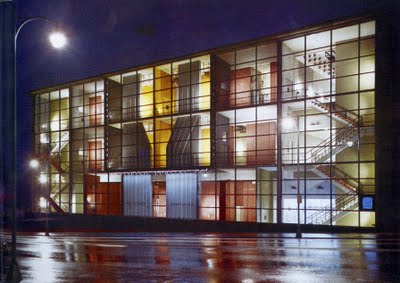
Although the original Dal Grauer Substation colur scheme was successful, Binning changed the colours in 1956 to bring the substation into harmony with the colours he had recommended for the design of the tall office building of the B.C. Electric Company rising next to the substation. Binning’s approach to colour was now deeply influenced by his study of the regional character of the natural context of the city. He was convinced that the most appropriate colouration of buildings in Vancouver would best enhance the urban scene by harmonizing with the northerly latitude and climate of Vancouver, with its surrounding rainforest, interlacing waterways, mist-catching mountains and greyer skies. Binning’s attention to architectural colour now began to emphasize greens, blues and greys, the scheme he applied to the new B.C. Electric Building and to the revised colour of the three-dimentional “mural” of its contigious substation.
B.C. Binning – A Passion for the Contemporary, Abraham Rogatnick.

The wonderful Dal Grauer Substation has been through seismic upgrading but some BC Hydro official came up with the idea that there could be an electrical explosion within the substation so a yellowing thick plastic safety "glass" was installed which has made the building opaque. The rest of the building has deteriorated and most who pass by never give our Mondrian a look. In September 2005 I had the opportunity to explore the inside of the substation. Architect Lance Berelowitz, below, cited the building as one of his favourites in Vancouver. So we got permission to take this picture here. The insides are full of that wonder that once made us dream that technology, and specifically electrical technology would save mankind from destruction and lead us to a rosy future. For me when I gaze upon the face of an architect I still see that belief.
It is a scandal that such a monument to the Post War Modernist Style has been pretty well let go by both our city and the executives of BC Hydro.
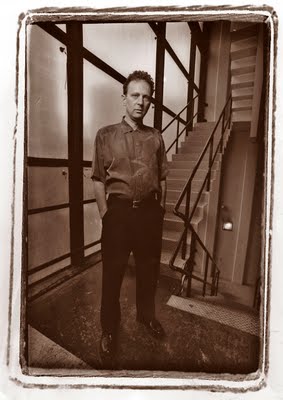
All photos here are mine with the exception of the colour photo of the substation which has no photo credit in the B.C. Binning book and was provided courtesy of the architect's wife.
Xantippe, Primogeniture, Subjective & Objective
Tuesday, August 18, 2009
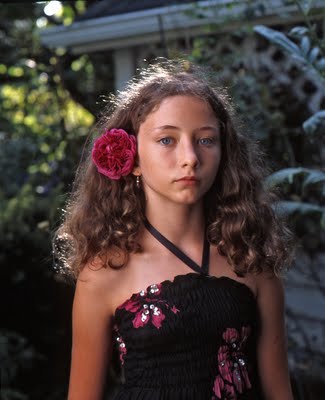
It seems to me that the biggest difference between British and American whodunits is that while the British ones, and in particular novels by P.D. James, stress that foul play more often than not has to do with a family will, American authors like the gore of serial killers. I dislike gore. This is why I read P.D. James, Colin Dexter and Reginald Hill. It is only recently that I have come to understand how family wills and family affairs can lead to serious crimes.
I have watched old couples in big houses in my neighbourhood be persuaded by their children that the family home is much too big and that moving to a cozier place might be an improvement. Understood in the suggestion is that whatever profits the couple might make those profits should be transferred in the direction of their children. Soon after the couples sell one of them dies and the other descends into dementia. It is for this reason that Rosemary and I have sworn to stay where we are and to be taken out in coffins. I am pleased to report that both our daughters agree on this.
But there are things, here in there, in everyday family interaction that make me still understand how right P.D. James is about human nature.
I remember that when our daughters were entering teenage hood, we had many family squabbles at our Burnaby dinner table. In fact I found out that, statistically, our squabbles were the norm and not the exception.
With some exceptions (and certainly I can not recall any P.D. James novel that would indeed be an one) it can all be narrowed to the scary technical term of primogeniture. Firstborns in wealthy families of the past (I rather like the Spanish primogénito) would inherit everything and siblings would become soldiers, priests or nuns.
When my Manchester-born grandfather Harry moved to Buenos Aires around 1902 he and his wife Ellen brought their son Harry. While it was never spoken out loud I did find out that my uncle Harry was born before his parents had married or perhaps he was even born from another mother. Most of the people who could confirm this are all dead so what I write herewith is conjecture. It was the custom in the Hayward family that the firstborn male had the middle name of Waterhouse. My uncle Harry never seemed to exercise this custom. My father was, in theory, if Harry was a bastard, the first born male of the Hayward family. He then had the exclusive right of saddling Waterhouse on me. I will not explain here how I came to have an older half-brother, Enrique who is also a Waterhouse. The explanation is also conjecture.
I had a sister who was born dead so my mother always told me that I was spoiled because I was an only child. She never really had the guilt or the problem of having to tend to more than one child. My mother was the eldest of a family of three (a sister and an uncle). My grandmother was showered by jewels made in Paris by her husband (my grandfather Tirso de Irureta Goyena). My grandmother became a widow in her late 20s and my mother had to take care of the family (she was 11) in New York while her mother worked. My mother received that monthly cheque from her mother and she did the shopping, the cooking and the paying of the bills. In some way my mother and her mother lived together for most of their life. My uncle and aunt financed their divorces with funds that were obtained by pawning my grandmother’s jewels. When my grandmother died my aunt and uncle wanted to share what was left of the jewels. At that point my mother finally rebelled and said no. When my mother died and I informed my aunt I was accused of being the son of thief and a thief myself. It is not too difficult to figure out that the problem is one that P.D. James would have understood and in some way had to do with primogeniture. My mother was the oldest but my uncle, the youngest, was the firstborn.
To this day my aunt will not communicate with me and my uncle who died some years ago did not either.
I watched my wife take care of our second daughter Hilary as we both deemed our eldest, Ale to be independent and self-sufficient. Hilary was shy, withdrawn and bullied mercilessly at school. It is only as an adult that Hilary told us of the bullying. Since Hilary took most of our time we did not give Ale our emotional support and perhaps we might have even been shy in the hugs and kisses department. I never realized that a child’s jealousy and resentment could have been a factor in Ale’s growing up.

Some years ago there seemed to be a rift between our daughters but with the advent of our two granddaughters (Hilary’s daughters, Rebecca and Lauren) the rift has healed and the two sisters are close in ways that they may have never been before.
And it is with the modern communication tool of MSN with its video connections that Rosemary and her older sister Ruth (she lives in Brockville, Ontario) that I have noticed the lowering of barriers and a genuine feeling that they are sisters, at last.
Of the above I will never know as my mother always harped on my being a spoiled only child.
Yesterday it was Rebecca’s 12th birthday. Rebecca had returned from San José El Cabo in Baja California on Saturday and she and her sister and parents went for a vacation in Penticton today. I called up Hilary on Sunday night and told her that Rosemary and I would like to see the girls for at least a couple of hours. We were granted our wish, and when I asked Rosemary to ask Hilary to dress up the girls in their new Mexican dresses, she complied, too. The girls arrived Monday afternoon and Lauren even had lipstick!
As usual (as she gets closer to teenage hood, it seems to be more usual) Rebecca was not too pleased in having to pose for me in the garden. But once she did she became the excellent subject that she always is.
In the garden she asked me who Socrates was. When I told her he was a Greek philosopher she asked me what a philosopher was. I explained that philosophers worried and thought of such things as death, life, existence and free will. I further explained that Socrates had a bitch of wife and that he hated writing anything down. I told Rebecca that thanks to Platón (much nicer sounding in Spanish), who did believe in writing stuff down, we have many of Socrates’ ideas to discuss today.
When I took this picture of Rebecca ( I took many and many of of Lauren and of the two together) I had a feeling about it. “Rebecca, I think this is your birthday portrait.”
While in Baja, Lauren (she is 7) received lots of attention. She was learning to swim. Rebecca swims divinely. When Hilary saw Lauren’s new Mexican dress she commented on her good taste and told her that her sun-bleached hair was beautiful. If you consider that these comments came so close to Rebecca’s birthday, you can understand why she might have felt a bit left out.
At our merienda (a Spanish tea-time that consisted of Filipino enzaiamadas, a special sweet bread baked with lots of butter, polvorones, Spanish short bread and Mexican hot chocolate, with lots of cinnamon) yesterday afternoon after our photo session in the garden I had a little talk with Rebecca. I told her of firstborns and how her mother had not been one. I explained that a first child (even if you are a father) is always most special. I explained that, subsequently, parents try to compensate by showering more attention on that second child.
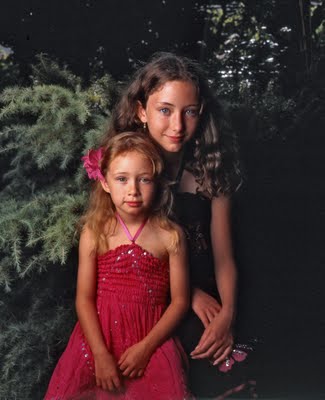
I invented and put words into Socrates’s mouth and told her that he would assert that you can look at things in only two ways, objectively (thinking with the mind) and, subjectively (thinking with the heart). I told Rebecca that she must not feel jealous or sad because of all the hoopla given to her sister. She understood when I said that she had to think about it all objectively and once she did it would all be fine.
When she left she gave me a big hug and now that she is gone on her vacation I must declare (subjectively) that I miss her a tad more than I miss Lauren.
Wetting Earth - Volcanoes - Mexico - México - Méjico
Monday, August 17, 2009
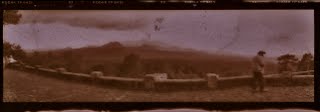
In 1952 my mother made an exploratory trip to Mexico City from Buenos Aires where we were living at the time. At the time Argentines insisted on writing Mexico as Méjico. The x does not exist in Spanish. Any words with an x come from Mexican words. The x in Mexico can be pronounced as sh in Xola, as an h in the pronunciation of México and in the Ixtaccíhuatl, the sleeping lady volcano it is pretty close to the English x. Taxco the silver town on the way to Acapulco is pronounce Tasco. That x is an s. The conquering Spaniards in Mexico insisted on replacing the x with a j and even today some Spaniards will not acknowledge the existence of the X.
As soon as the Spaniard were thrown out in the 19th century the Mexican, in particular brought back the x. The Tejas Indians (pronounce like just like that) ended up as the Texas Indians which gave us Texas and the San Antonio County called Bejar was changed to a difficult Bexar so practical tejanos (nationalities in Spanish are never capitalized so canadienses are just that) simply call it Bear County.
When my fellow classmates asked me where my mother had gone I said, “Mexico,” pronouncing that x like an x in English. It sounded as exotic as Samarcanda or la Cochinchina (Vietnam).
When my mother returned she spoke of great volcanoes and mountains. I had never seen the Andes so mountains were as strange as polar bears. My mother spoke of the colour of Mexican earth and of the Aztecs and the Mayas. She brought me an obsidian knife and a little idol that smelled of dry dirt when suddenly rain falls on it. Mexico was a land of wonder and magic. When we left for Mexico to live I was prepared for an adventure.
That adventure has never ended. It persists every time I go to Mexico. I took this picture in Michoacán, Mexico three years ago. The volcano in the picture is Paricutín. A storm was about to hit and when it did it poured. When I saw this scene it became the Mexico of volcanoes that my mother had told me about. And when it began to rain I could smell that wonderful smell of wetting earth.
August & Our Urban Malaise
Sunday, August 16, 2009
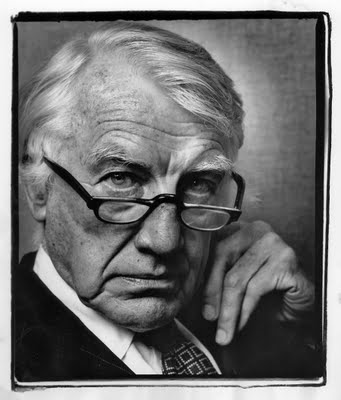
In past years when I was an extremely busy freelance photographer I would call my friend, writer John Lekich and complain to him of a particular period of enervation I was going through. Lekich would tell me, “It’s spring. It’s the weather. What do you expect? Too many things are growing out there for you to worry about work.” I would call him a few months later and he would modify his advice to, “Alex, it is summer. Don’t worry about not working. Just enjoy the weather and your garden.” Come fall Lekich would say, “It’s fall so that’s why you don’t want to do anything. Come winter you will be back on course.” And, of course, when winter came, and my inactivity would make me call Lekich, he would say, “Just wait until spring and you will want to work again.” Luckily the year has only four seasons. If it had more Lekich would give me more excuses to not lift my shutter finger.
I don’t want to call him about Vancouver’s August as he would justify any inaction on the part of our city fathers, politicians, city planners, etc. In fact I can assert that in August nothing happens in Vancouver. Those who make the decisions that might affect our urban life are gone on vacation. When they come back in September they often make up their minds behind closed doors. These decisions are implemented as fait accompli. By the time our conventional media is made aware of them we are suddenly informed and there is no possible recall.
While I am a bit of an elitist, and I do not believe in a giving the vox populi more than cursory power in the affairs of a city I do not believe in leaving them completely in the dark. I believe we are in the dark about the decisions that are currently being made about the expansion of Vancouver and the respect and preservation of those places so important to our urban wellbeing.
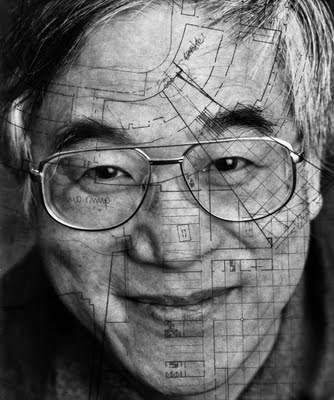
In the late 90s and a few of the years into this century there were a couple of organizations that made me feel alive as a citizen of this city. By citizen I mean the feeling and the power of being part of a city, this city. In the middle 70s when I had visitors from abroad I would take them to see the Erickson/Massey Simon Fraser University at night. The university was all lit and it seemed to be a beacon of cultural pride. Its steps reminded me of the centres of Greek city states and the Roman Forum.
In those late 90s the urban steps of Erickson’s Robson Square led to what was then called the Robson Square Media Centre which held lectures sponsored by ALCAN or the wonderfully, almost secretive, Urbanarium Society founded by Ray Spaxman, Vancouver City Planner extraordinaire. These lectures were held in a superb (Erickson designed!) auditorium called the Judge White Auditorium. Few of these lectures ever made our newspapers even though I could often spot architect Arthur Erickson sitting there. He always had something interesting and startling to say. Nothing of what he ever said seemed to be recorded by any media. Near Erickson I would spot Alderman (at the time they were called that) Gordon Price (with a copy of the day’s New York Times on his lap). He was the only person from City Hall who understood what it was to have a sense of urbanity and the importance of urbanity in relation to culture. At these lectures I heard about my city and our local architects and many of fame from abroad told us of our good points and what we must do to keep our city a livable one. In the most memorable one (held at the then new Roundhouse) the panelists where Carole Taylor, Arthur Erickson and the then city planner Ray Spaxman. The lecture was about the densification of our city. It was Erickson who said something like, “Our city will be thin in population by mid 21st century. We can ignore it and do nothing and then cope with the resulting chaos. Or we can prepare of it now. The density will be inevitable.”
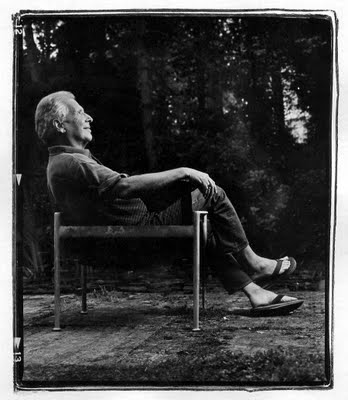
At a later ALCAN lecture, architects Bing Thom (above, right) and Arthur Erickson (left) argued for the building of a tunnel under Burrard Inlet joining the North Shore with our city somewhere, perhaps, at the foot of Main. Again both architects told us that there was no way we could prevent the city from expanding to and beyond Lion’s Bay. “It’s going to happen. Depending on a three-lane bridge is madness.”
It was a couple of years ago that I heard former Premier Mike Harcourt at a lecture at the downtown campus of Simon Fraser University say, “The centre of our city, let’s call it Greater Vancouver, is Surrey City.” To me this was startling. I combed the papers the next day. Nothing.
I have friends and a particular architect friend, Abraham Rogatnick (below, centre), who would like to see our Vancouver Art Gallery stay where it is. Rogatnick's arguments are persuasive. I have since talked with a well known former dance crititic from our leading daily who was present (our former critic is also been known to defend the arts and culture by working with the Canada Council) at meetings where several and practical solutions to the “lack of space” problem of our gallery were presented and discussed. It seems that Simpson Sears at one time was willing to forgo two of its floors. Plans were discussed of building escalators that would join the gallery to a building that is a perfect box for an extension to our VAG. Since the box was designed by the famous architect Cesar Pelli we would have an art gallery extension of some renown even if most in the city hate Pelli’s design.
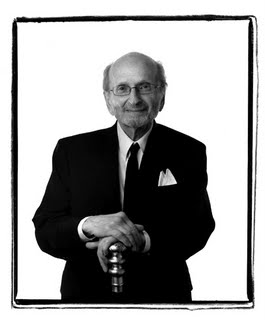
I have written here how, behind close doors, the hiding and the eventual virtual destruction of Paul Merrick’s CBC has resulted in an objectionable mish mash of ugly densification.
Some of us (at least I do) want to know what the city plans to do with our main Post Office.
Some of us (at least I do) want to know what the city is going to do with the former location of the Greyhound Bus Station on the side of the Queen Elizabeth Theatre.
Some of us (at least I do) want to know when the city going to restore the Dal Grauer Substation (on Burrard next to the Electra Building)to its former glory.
I read with shock that City Hall owns all the land, North, to the edge with West Broadway and that a plan is afoot to build a new City Hall! Some of us (at least I do) want to know what this plan is.
In the 80s and 90s we had a few architects who would go public on urban affairs. There was Ned Pratt (first photograph, top left), Arthur Erickson and Bing Thom. Two are now gone and I have not recently heard Bing Thom on anything although I know he may be fighting behind closed doors (Is this the only way of fighting fire with fire, fighting our city’s lack of transparency in its decision making?) at all the work that is being done to modify Erickson’s vision that was Robson Square?
Robson Square would have been a Socred fiasco. I would like to remind those with that peculiar short civic memory, that this former right-wing party sort of re-named itself and is our our Provincial Liberal Party. When the NDP won the Provincial election in 1972 the Socred plan to build a skyscraper on what was to be called Robson Square became instead a project designed by Arthur Erickson that Erickson likened to laying the skyscraper on it side. It is that advocate for the works and memory of Arthur Erickson, the tireless Cheryl Cooper who recently told me, “Arthur’s vision had the law and justice on one end (the law courts) and art (the VAG) on the other , and smack in the centre of Robson Square an urban plaza smack in the centre of the city.”
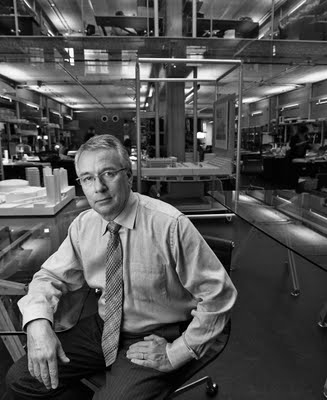
In those wonderful 90s Robson Square was an urban Mecca for me. Walking its steps, like the ones at Simon Fraser University gave me a sense of civic participation. Before the building of the big box Chapters (I must confess the books are cheaper) the area attracted me with Duthie Books, a Murchie’s where I could scan the books I had purchased across the street and an art gallery that I felt was mine. With Murchies and Duthie’s gone, replaced by high-end boutiques of clothing I would never buy, the area is not a beacon for me anymore.
Part of the problem is the complete failure (my humble opinion) of the University of British Columbia’s takeover of Robson Square. They have quietely and with no fuss removed all of its urbanity. The wonderful Judge White Auditorium (with those carpeted steps on the side where some of us would lie down, instead of sitting in the standard seats) was destroyed and converted to office space. How many people who know for a fact that Simon Fraser University has a downtown campus even know UBC has one, too? Former “Alderman” Gordon Price organizes lectures on urban affairs there. The few lectures I have gone to at the almost invisible UBC downtown campus have been partially organized by the Istituto Italiano di Cultura.
How many people are aware or ever think of visiting the UBC Bookstore that is in its downtown campus? I have been told that former UBC President Martha Piper was singly responsible for eliminating all the restaurants that were in Robson Square by forcing them to renew their liquor licenses on an almost monthly basis.
The only light in the darkness of “what are they doing with my Robson Square?” is the VAG’s extremely successful Art Gallery Café. My granddaughter Rebecca loves going there and tells me, “This place is nicer than Starbucks and it plays better music, too.”
I would like to see a formal or informal committee of committed architects (including Peter Busby, above right) and urban planners who would publicly discuss these urban issues in a transparent way and somehow urge and nudge our city, our province and our Federal Government to clue us in as to what they are planning to do with our money. Perhaps this informal committee would somehow erase that August malaise and make the citizens of our city behave like citizens of our city.
Addendum: In the SFU City Blog Gordon Price, the Program Director corrects one of my statements above. I am extremely happy to be wrong on this one!
... but we have to note that in fact the Judge White Theatre at Robson Square still exists. Indeed, we at SFU have used it for our Shifting Gear’s series in partnership with UBC’s Bombardier Chair.
Lauren - Not Yet In Her Little Red Dress
Saturday, August 15, 2009

The surgeon looked at the adjutant-general, gravely and significantly. The patient's eyes slowly closed, and thus lay for a few moment; then, his face suffused with a smile of ineffable sweetness, he said faintly: "I suppose this must be death,"and so passed away.
Parker Adderson, Philosopher, Ambrose Bierce
Today was eventful but trying in many ways. I discussed the act of willing oneself to die, with a friend who has been admitted to hospital. We talked about fearing death. I mentioned Ambrose Bierce’s Parker Adderson, Philosopher who is a man ready to die in the morning but not the day before. I attended the memorial of Vancouver poet Gerry Gilbert at the Roundhouse. Gilbert died a couple of months ago and the folks who were there represented an era long gone. It was an era in which poets listened to musicians. Musicians listened to poets and painters and architects listened to musicians and poets. Now, a speaker at the memorial noted, there are many more poets but fewer that seem to be good. When I say the same thing about photographers I am told I am too critical.
The day had to be a day of melancholy and it was until almost the end. I managed to get Rosemary into the car and even managed to fold a wheelchair and put it into the trunk. With Hilary we went to the airport to pick up Lauren and Rebecca. They had gone for two weeks to San José el Cabo in Baja California with our daughter Ale. Many years ago Rosemary and I would send Ale and Hilary to Mexico for several weeks to spend time with the Zamoras. It was with the Zamoras that Ale, Rebecca and Lauren visited this time.
Rosemary and I always enjoyed going to the airport to see how our daughters had grown and to note their tans. It was the same all over again with our granddaughters.
But there was something different – an unexpected different. Rebecca looked much the same and most lovely as usual. The little shock was Lauren. Lauren had grown and looked older and much prettier than when she had left.
When we arrived at Hilary’s house the girls opened their luggage. Ale pulled out all sorts of Mexican sweets. But it, was Lauren who captured my heart. She pulled two nice Mexican dresses, one a brilliant carmine red. "I picked these dresses so you can photograph me in them," she said to me.
Yes!
Addendum courtesy of Brian Nation (present at Gerry Gilbert's memorial) who sent me an email with the subject "No Exit"
From now on memorial attendance for dead jazz musicians, photographers, and bums only.
b
Nation included this photograph which I rather like which he took of me outside the memorial service.
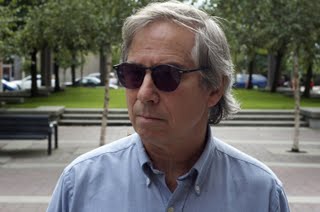
Winston Carlyle Miller & His Orphan Client
Friday, August 14, 2009

In the late 70s I had a lucrative contract taking industrial and PR photos for Canadian Pacific Limited. I took pictures of CP trucks, planes and trains. I photographed train crews fixing rail lines and once even got the chance to photograph the Royal Hudson being repaired at the Round House (now The Roundouse Community Centre) on Drake Street. The contract with CP brought me good money so I decide to attempt to double it by getting a job doing the same for Air Canada.
Harry Atterton, the public affairs manager for Air Canada liked my portfolio but told me that he already had a good photographer. I left a bit glum. It was about six months later that I read in the Vancouver Sun that a photographer had died suddenly of a heart attack. He had a wife and two daughters. The daughters were about the same age as my own. It was the photographer for Air Canada. I received a call from Atterton a few days later offering me a job. Not long after I got another call (a cold call) from an life insurance agent wondering if I wanted to buy a policy. My yes was instant. I bought one. Rosemary did not like my agent citing his used car salesman qualities. I really did not care at all as long as I was insured. But then I started running into my agent at Wreck Beach. There is something odd about having a conversation with your life insurance agent when both of you are in your birthday suits.
In the beginning of 1986 I received another cold call this time by a man whose voice sounded like Sidney Poitier. He asked me what kind of insurance I had and somehow he convinced me that it was the wrong one and that he would make it right.
Winston Carlyle Miller looked very much like Sidney Poitier and even shared that skin colour. While Poitier was from Miami, Florida, Miller was from the more exotic Georgetown. He quietly and smoothly nudged me to cancel my former policy and to switch to his company (Transamerica). He even sold a policy to Rosemary. He calls me on my birthday and his soothing voice never intrudes that much even when I tell him how bad business seems to be for me.
I photographed Miller in the garden three weeks ago. It was like having a friend in my garden. I realized I have known him for 23 years. His voice is still that voice but his Poitieresque features are perhaps less evident now.
Yet as I watched Sidney Poitier in Lilies of the Field today it seemed like it was Miller who was building that chapel for the German, Austrian and Hungarian nuns. And I have to point out that Winston in his short-sleeved sports shirt looks as good as Poitier did in his.
Real Polo
Thursday, August 13, 2009
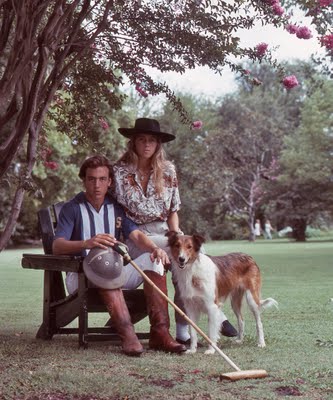
As a little boy when I accompanied my father and mother from our residential neighbourhood of Coghlan downtown we took the Bartolomé Mitre train that took us past Belrgrano R to our destination of Retiro which was the end of the line. On the way, where the two different Mitre lines (the other passed a station called Belgrano C) merged to head towards Retiro, the trains would pass by the forested Palermo Park which was and is even today full of stadiums. There were soccer stadiums, rugby stadiums, Olympic sports fields, and the Hipódromo Argentino de Palermo where the horse races were held. On weekends, when my parents often took me to the movies on Calle Lavalle, there would be games being played on the stadiums or I would see the horses on the way to the finish at the hipódromo. But the rarest and most exciting sight for me was when looking out of the window I would see the elegant and prancing ponies on the polo field.
Years later when I was in the Argentine Navy I would often go to Palermo on Sundays to watch a polo match or my cousin Georgito O’Reilly play with his rugby team, Club Atlético San Isidro(CASI). I thought myself too refined to go to the many A-League soccer games being played on any Sunday afternoon.
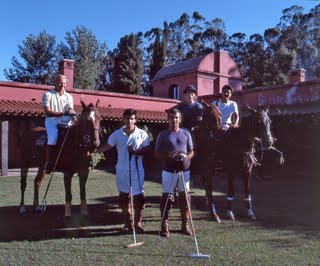
To this day I admire the look of the real Argentine polo player. The look comes surely from the fact that to play polo you need a lot of money and idle time to practice. It is the combination of idle time and practice that makes the Argentines the best polo players in the world. As I look back at these photographs I note that this is as authentic as polo can ever get. Poor old Ralph will never really get it. You see, to be authentic you have to have a bit of the gaucho. The gaucho may not have been elegant or smart but he certainly could ride that horse.
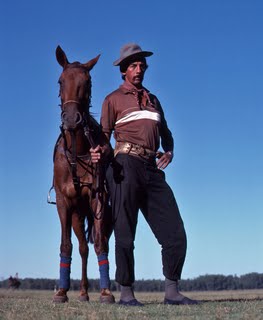
Not Taking It For Granted That It Will Always Work
Wednesday, August 12, 2009

About once a year I am not able to transfer my photographs from my computer's hard drive into the blog using my FTP server. The problem, in every case, has been an issue with Blogger which is owned by Google. This means that technical support is non existent and even an acknowledgement that there is a problem is rarely ever posted by Blogger. I have stopped trying to see if the problem is in my computer. A way around the problem is to upload my photographs on to a web-based photo site (in my case it’s called Photobucket). Then by using the HTML address of the photo the picture appears like magic here as is the case now with a portrait of Rebecca I took last year. My fuzzy knowledge of HTML prevents me from customizing the position of the photo. About all I can do is select tiny, medium and small.
Furthermore I have learned to ignore the indication from Blogger that my blog is taking longer to publish. If I wait for the publish sign it could be hours or days. I simply open my Explorer again and check my blog. The blog is published in spite of the warning that it isn't.
This year's turmoil (the last five days) has coincidentally (?) happened when I experienced problems with some web sites like the Globe's and some videos from the NY Times. I decided to find out by calling Telus tech help. It took me three days before I finally got through. My call was taken by what must have been a very young cababayan of mine (a fellow Filipino countryman/woman). She did not respond directly to any of my questions. She would answer, "Can you hold? Let me ask." My question was, "Is the web or in particular Telus having speed issues in BC?" After some back and forth she finally acknowledged that it was and has been a Telus issue in BC for the last four days. There is no recording or any information on this on any Telus site.
This is certainly not a rant. I have vowed not to have any on this blog. But surely customers should be informed of technical issues that prevent us from finding out why our web connection is not working properly? Surely now that checking one's e-mail every morning is as important as being able to turn on the lights in the kitchen to make breakfast should mean that Telus and other internet providers must have the same obligation as BC Hydro to satisfy its customers. Yes 120 volts, 60 cycles and 100 Mbps!
T&A No More
Tuesday, August 11, 2009

Five years ago I went to Buenos Aires with Rosemary and Rebecca. Wherever I went I saw the near naked and young female figure advertising everything from eyewear to toothpaste. I asked my Irish nephews why this was the case. I told them that the images were almost obscene to me. My nephews were puzzled and jokingly challenged my manhood.
It was some 20 years ago that I shared a show of nudes with two other photographers. My nudes included my subject’s faces. I remember that there was one salient comment in the gallery guest book, “ Alex, thank you for showing us the faces.” When possible my nudes are always also portraits. At Focal Point I have been teaching for some time The Contemporary Portrait Nude. If I were to try to explain the concept to my nephews they would smirk and comment to what lengths I go to justify taking pictures of naked women.
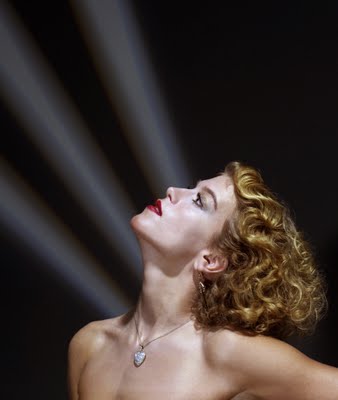
It is difficult to try to explain not only to my nephews in Argentina but my friends in Mexico about what has happened to the traditional male-oriented approach to sexuality or to the language men (at least in Canada with my own contemporaries) used to used to use when speaking of women.
In the 80s and early 90s I was an enthusiast of female exotic dancers. I never drank in these establishments as I have never enjoyed drinking. My interest in these bars was to gaze on the female figure in all of its glory. My enthusiasm waned and disappeared one evening at the Marble Arch 10 years ago when I was there with some architect friends and a journalist. This bunch was very much in control of their drinking habit. They would invariably drink a couple of pitchers of beer and at a certain point they would stand up (extremely sober) and go home. Some were married and they were going home for supper. But on this one evening one of them told the rest, “Let’s wait to see her ti.. before we go.” I had heard this expression for years and I had never given it much thought. This time I was shocked and disgusted. I never returned and I have not seen an exotic dancer since. My nephews would laugh at me, “¡Che, necesitás Viagra!
It is in the spirit of the above that a much kinder and respectful man, this man has to make a confession. In the late 70s ane early 80s I used to take still photographs of CBC variety shows. The TV cameramen and I would often ogle the female dancers that were part of the troupe called The Jim Hibbard Dancers. In particular it was Hungarian-born cameraman Michael Varga and I who really liked to compare notes. We loved staring at Viktoria Langdon. She had the most perfect legs we had ever seen or that I have ever seen since. To top the legs she had Cinemascope cheekbones and a sophisticated (to us) South African accent. Then there was Jackie Colman who had sex appeal. This term has pretty well disappeared. In the 50s men and women would say, “He or she has SA.” Everybody knew what SA was! In contemporary language you would say that Colman had bedroom eyes and sex rushed out of every pore of her body. If the minimum clothing that these dancerw was much too much we could always catch Colman at the No Five Orange sans costume.
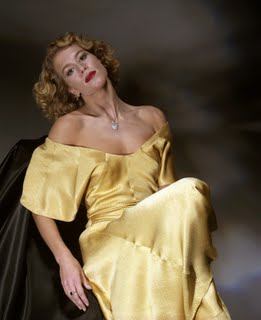
Jackie Colman had this Mezzo-soprano voice and she often spoke to us as did Viktoria Langdon. There was a third dancer who was in a different category. She was remote. When she wasn’t dancing she was preening or stretching. I was mesmerized watching her. She was like watching a spirited Arabian horse. Mike and I thought she had the most perfect bum (we used the word that is a synonym for donkey). The rest of her body was compact and her legs were beautiful.

She had a narrow, almost streamlined face. Her blond hair was wavy. In was in the mid 80s that I had my chance to photograph her in my studio for Vancouver Magazine. I used Hollywood lighting and I stupidly ( I repeat, stupidly) arranged to cover most of her body with clothing. Here she is in all her clothed glory. But there is that picture that I snipped from some contact sheet that is inside the Whalley, Moira file. I know that the dancer on the right is Whalley. I am sure that my nephews would find that picture to their liking.
Bill Featherston's Guardian Angel
Monday, August 10, 2009
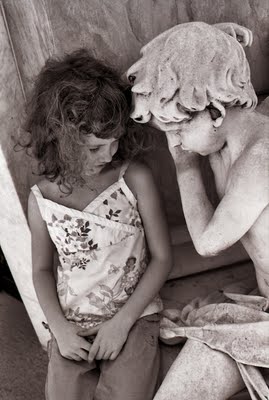
I met Vancouver painter (he lived in Brackendale outside Squamish, B.C.) around 1980. He was a jolly friend of Mac Parry who was the editor of Vancouver Magazine. Featherston was tall, well built and with his beard and baseball cap he reminded me of Hemingway. And he drank like Hemingway. One day he arrived and asked to borrow money from Mac. He told Mac that he had spent the night at a cheap local hotel after having had lots to drink. He woke up in the hotel minus his wallet. His penchant for fun and drinking he shared with other friends of Mac. One of them was Mati Laansoo who drank like a Baltic carp (he was from Estonia). It was about this time that Featherston had a one man show at the Bau-Xi Gallery (not mentioned in Featherston’s curriculum!) where he painted Mati and himself naked and the theme of the show was his hate for art critics. I remember that one of his paintings may have been called Kill The Art Critics. Nonetheless his show was given not bad reviews by the men he attacked so boldly. I observed this happy man and I wondered how he managed to drive from Vancouver, almost every day, all the way to Brackendale (one of the most dangerous highways in Canada) without a mishap. He taught at what was then called the Emily Carr College of Art. Alcohol and the Sea to Sky Highway could have never been happy partners. It was then that I found that the only explanation for Featherston’s survival (he died, not in a traffic accident, in May of this year) could only be the intervention of a most efficient and personal guardian angel. In fact I have used Featherston’s case as my proof for their existence.
Since I can remember I had a little oval mirror the size of my hand (now) which had a brass guardian angel attached to it. It was pinned to my crib and then to all the little beds I had subsequently. The little guardian angel survived (and it hung behind my first daughter Ale’s crib) until 1969 when my Aunt Dolly visited us in Mexico City and saw the angel. She said it was her son Robin’s. She took it with her. I wondered and never asked how the little angel had come to be with me for so long. The little angel had been part of my life as much as a little almohadita (an ever so beautiful word that comes from the Arabic and means in Spanish a little pillow) which I had in my bed until I was 8. My mother told me that I was too old to cling to it and took it away. I grieved for days. Even now I cannot sleep unless I have two pillows- one for my head and one to hold. Rosemary stopped being jealous some 41 years ago. In the Philippines they call the pillow a man’s mistress. In pre-air conditioning times men (and women of shameless and questionable morals!) would sleep with a cooling pillow between their legs to ward off the sweat of legs caused by the stifling tropical climate of the Malayan islands.

Somehow I survived losing my childhood bed companions and it did not become an issue until Brother Edwin Reggio, C.S.C. taught us at St. Edward’s High School sometime around 1958 the pyramid of life in its "upward" goal to complexity. He started with rocks, went to slime, viruses, bacteria, insects, fish, birds, reptiles, mammals and then told us that the jury was still out that asserted that only humans had souls. Brother Edwin accepted that “lower” orders might have some sort of rudimentary soul. The Catholic Church had no arguments with Darwin as long as we believed that at some point God intervened and injected a soul into some version of early man (and Eve). From man, Brother Edwin continued with his pyramid of souls. The next were the angels and he explained the different orders, Seraphin, Cherubin, Thrones, Dominions, Virtues, Powers, Principalities, Archangels and Angels. He also explained how man was a blend of body and soul, while angels where pure spirits with imperfect souls. Only God was the very soul of perfection. All this made sense to me then.
Now I find it much harder to accept the existence of that Supreme Being, and more so One that is concerned about life in one little planet in a universe of planets and stars. I am too mathematical to believe to the contrary. I won't fall for Pascal's argument in his famous wager. I first started having doubts when I thought to myself in what stage of my mother’s life I would find her if she were in heaven when I died. It seemed that the answer was as ludicrous as trying to find out how Santa Claus managed to navigate down narrow chimneys.

I find it much easier to believe in the existence of those luminous but imperfect spirits that are angels. Bill Featherston might just wink at me from wherever he might be. Or, he could be fluttering his feathers.
On Photography - Sontag's Ecology Of Images
Sunday, August 09, 2009

The powers of photography have in effect de-Platonized our understanding of reality, making it less plausible to reflect upon our experience according to the distinction between images and things, between copies and originals. It suited Plato’s derogatory attitude towards images to liken them to shadows – transitory, minimally informative, immaterial, impotent co-presences of the real things which cast them. But the love of photographic images comes from their being material realities in their own right, richly informative deposits left in the wake of whatever emitted them, potent means for turning the tables on reality – for turning it [in italics in book by author] into a shadow. Images are more real than anyone could have supposed. And just because they are an unlimited resource, one that cannot be exhausted by consumerist waste, there is all the more reason to apply the conservationist remedy, if there can be a better way for the real world to include the one of images, it will require ecology not only of real things but of images as well.
The last paragraph of Susan Sontag’s On Photography, 1977
I have photographed many sports once. It after you photograph them that you become an expert and not before. Only practice at a sport with a camera will allow the photographer to realize when peak and important moments happen. In baseball when the bat connects with the ball, at that very moment the bat and ball are at rest. The same happens in ballet and modern dance. If the photographer captures the movement before that peak of completion, the picture will most often look ungraceful. Movements have to be caught at the end.
The photographer who was an expert at this was New Zealand born American photographer George Silk (1916, 2004) who shot sports pictures for Life Magazine. I remember reading in a magazine a quote from him in which he said (I cannot quote it exactly), "I have had access to the fastest motor drives for cameras. I can shoot at 18 frames per second. I have noticed that the best shot is most often between frames." What Silk was saying is that the photographer, after some experience, is able to predict and anticipate that peak movement. A machine motor drive cannot.
When editorial photography began to languish some years ago I was forced to cut my costs wherever I could. The insurance of my cameras was the first to go. I had come to the conclusion that in owning duplicate equipment I could afford to lose half of it to theft. Then instead of charging clients for a whole box of Polaroid (20 exposures) I began to charge for the actual number of Polaroids taken. I learned, too the frugality of shooting fewer exposures with my 10 exposure Ektachrome film. At some point I freaked out an art director when I showed him an assignment I had shot with two exposures. His comment did not trouble me, "One of these works for me. But what if it didn't? You don't have enough of a range. You are going to get into trouble." I cannot remember when he ever assigned me to re-shoot anything. But I do know that I have finished assignments with half the roll of film exposed and feel it wasteful to have the film processed without shooting the rest, just in case. I have not allowed that to bother me and I have had film processed or processed my rolls of b+w film that were not all exposed. The urgency to provide a magazine with results prevented me from waiting to expose the film on other projects or assignments. But I have conserved my system of noticing as much as I can what I am about to shoot before I press the shutter.
As I watch the average person shooting their digital cameras or my students at school it is patently evident that they do not believe in Sontag's ecology of images. They shoot a lot and often. When I ask to see three of their best images many of my students have a problem selecting three.
For a while I had some of my more gullible students worried when I invented the term "etching your sensor". I told them that the constant and rapid firing of their digital SLRs would etch their expensive sensors and the repair would be expensive.
Elements of my Mamiya are 30 years old. Film cameras really did not go through the rapid obsolescence of modern digital cameras. My guess is what modern photographers save in not using film has to be set aside to buy new and improved equipment.
As a teenager I used to haunt the used cameras stores in Mexico City and I would stare and lust after those Edixas, Praktinas, Leicas, etc. I do believe that obsolete digital cameras must go to the same place that a sock in the drier goes when it mysteriously disappears.
I wonder if Sontag could have ever known that her idea of ecology of images would some day be in so critical a stage of application as it is now. So many pictures and so many of them the are the same. So many pictures and so few are essences. Plato would have deplored it all.
Above is a sequence that I took of Rebecca at a tea shop in Punta del Este, Uruguay in 2004. The final image, bottom right was the one. I stopped right there.
Photography is a system of visual editing. At bottom, it is a matter of surrounding with a frame a portion of one's cone of vision, while standing at the right place at the right time. Like chess, or writing, it is a matter of choosing from among given possibilities, but in the case of photography the number of possibilities is not finite but infinite.
John Szarkowski
On Photography - Candice Bergen - My Failure
Saturday, August 08, 2009

I always prefer to work in the Studio. It isolates people from their environment. They become in a sense…symbolic of themselves. I often feel that people come to me to be photographed as they would go to the doctor or a fortune teller – to find out how they are. So they’re dependent on me. I have to engage them. Otherwise there’s nothing to photograph. The concentration has to come from me to involve them. Sometimes the force of it grows so strong that sounds in the studio go unheard. Time stops. We share a brief and intense intimacy. But it’s unearned. It has no past…no future. And when the sitting is over- when the picture is done – there is nothing left except the photograph…the photograph and a kind of embarrassment. They leave…and I don’t know them. I’ve hardly heard what they’ve said. If I meet them a week later in a room somewhere, I expect they won’t recognize me. Because I don’t really feel I was really there. At least the part of me that was…is now in the photograph. And the photographs have a reality for me that the people don’t. It’s through the photographs that I know them. Maybe it’s in the nature of being a photographer. I’m never really implicated. I don’t have to have any knowledge. It’s all a question of recognitions.
Richard Avedon
It was sometime in the winter of 1986 that the Georgia Straight dispatched me to a mansion in Shaughnessy to photograph Candice Bergen. She was filming an episode of CBC’s highly rated Lies From Lotus Land (why does the CBC not do anything like it now?). The other actors in the episode were Bruno Gerussi, Jackson Davies and a striking and darkish young man I had never seen before.
I was off on the wrong foot from the very beginning. I approached Ms Bergen and told her I had been assigned to photograph her. She immediately began to shout at the director and said, “Why was I not informed? I have no makeup. I am not going to pose for anybody without makeup. I am simply not ready for this.” I interjected, “You are perhaps one of the few Hollywood actresses who do not need makeup. You are fine as you are.” She looked at me and melted just a bit and told me, “Wait about 30 minutes and I will pose for you in the attic upstairs.”
I went to the attic and found an empty room with a cane back chair. In 1986 I was still crazy about 40s Hollywood lighting and I had brought my portable spotlight. I set it up and used a secondary light (with a grid) as a hair light.
She came into the room, sat down and smiled. I noticed her Olympic ski jump nose (sort of like Richard Nixon’s) and I knew she would never do anything but look straight at my camera. I attempted to speak to her. I attempted to connect in some way. All I got was that wonderful smile. I remembered friends who had told me that when she appeared in Mike Nichols 1971 film Carnal Knowledge with Jack Nicholson critics commented that her sexual climax scene was devoid of any passion or emotion. The critics asserted that her father’s (Edgar Bergen) wooden dummy, Charlie McCarthy was capable of showing much more emotion.
That very week I had purchased For the World to See – The Life of Margaret Bourke – White. It was Bourke-White who had photographed Gandhi spinning cotton and it was the wide dissemination of that photograph that finally convinced the British to give up their empire in the Indian sub continent. Candice Bergen had played Bourke White in Richard Attenborough’s 1982 film Gandhi.
I decided to use a technique that I had never ever tried before. I was going to see if an insult would force Bergen out of her protective shell.
“Ms Bergen, I just received a wonderful book on Margaret Bourke-White. After some thought, I have come to the conclusion that you had nothing in common with the photographer. A few years after the film, Bergen had become an amateur/professional photographer and she appeared in film and camera ads in photo magazines. She preceded our very own Bryan Adams but was never even remotely as good as other amateur/professionals like Senator Barry Goldwater, Dennis Hopper, Oscar Peterson and The Police guitarist Andy Summers.
I watched her face through the big viewfinder of my Mamiya RB-67 and I noticed nothing. There was not a flicker of acknowledgement of my insult. She kept on smiling. I thanked her. She smiled and left the room leaving with no more knowledge of what she was about than when she had come in. I went downstairs and watched the actors in their roles. I was mesmerized by the performance of the young man. I lingered. During a break I asked him if he would pose for me, “Sure he,” said, “But it will have to be in an hour when our next break is.” I lingered for a bit longer and thought to myself, “I want to go home now. This guy will probably never amount to anything.” I left.
And that is how my failure to photograph Candice Bergen was compounded by my not taking a picture of a most willing Keanu Reeves.
Babies, Weddings & Pornography
Friday, August 07, 2009

When I decided to become a photographer and I arrived in Vancouver I told myself there were three things I was not going to do and that was to shoot weddings (and bar mitzvahs), babies and pornography. The first two self prohibitions came out of previous failures or near failures in Mexico. I had shot a couple of weddings in Mexico City and I had been plagued by bad equipment and flash connection problems. Shooting weddings was much too stressful. Re-shoots were out of the question. Someone I knew hired me to photograph his beautiful baby girl. He never told me that she was a Thalidomide baby. When I saw the child, sheo was missing limbs and fingers I did not know where to begin. I have stuck to my guns since. I was ordered by Mac Parry to photograph Susan Musgrave getting married in jail for his magazine Vancouver Magazine. Joey Shithead made a request I could not refuse and I photographed his civil wedding. The only babies I have photographed, and gladly, have been my two granddaughters, Rebecca and Lauren. With pornography it gets a tad more complicated.

The only porn film I had ever seen before I arrived in Vancouver in 1975 was the inevitable Deep Throat. I had not warmed much to the experience in a movie theatre in San Francisco. I have a lingering memory of two men sitting in front of me watching it while munching on pop corn. I lost all interest in pornography. When I saw a few Penthouse centerfolds that featured women fingering sharp, colourful and shiny pudenda I saw it as pornography. It was the colour and the shine that imparted that difference that separated art and or artsy b+w nudes from these.
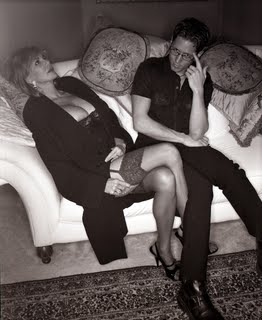
Sometime in the middle 80s Les Wiseman interviewed porn star Marilyn Chambers and I accompanied him to take her portrait. The excuse for the interview which was published in Vancouver Magazine was that Chambers was in town with her country & western band. When we left the Four Seasons Hotel where Chambers was staying with her manager and husband Chuck Traynor I asked Les, “Do they actually do it on film? “ Les looked at me and laughed.
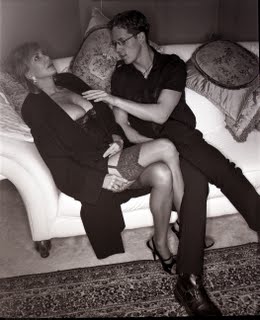
It may have been at least 12 years when I visited Wiseman at his coach house near City Hall. He let me in and went to his TV console and opened its doors. He played a video and he answered my question as if it had only been posed a few seconds before, “See Alex, they really do it.”
But I have always thought that had photography in the 19th century begun with the Lumiere brothers’ photographs in colour and not Daguerre’s Daguerreotype process we would have immediately adopted photography in colour as art. And perhaps I would have looked at those Penthouse centerfolds with more of a discerning eye. There is that residual memory in those of us who are of a certain age that associate b+w nudes as art and the equivalent in colour as smut. I could prove this to the contrary with pictures that I have taken myself, in colour and in b+w but I have a self-prohibition about publishing such stuff or nudes in this blog.
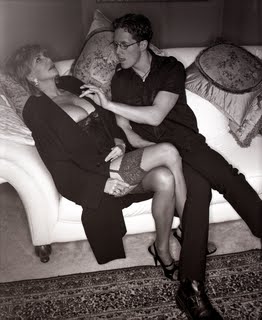
I will be the first to not only admit but assert that the photography of the undraped human body is high in sexual content. The photographer who says, “I love how the human form can mimic a Sahara Desert sand dune,” is in complete delusion. If it weren’t so the photographer would be happily taking pictures of undraped dromedaries.
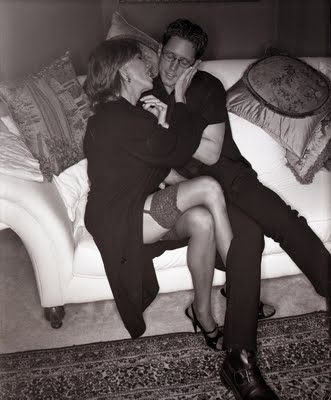
I have photographed many nudes in my years in Vancouver and I even teach a class at Focal Point called the Contemporary Portrait Nude. I gave it that title because to me the nude has never been about parts but about the humanity of the person posing. Sometimes the face is not there but there are ways of implying it. It is only of late where I have sensed a waning in my passion for photography of the undraped. It must have a lot to do with being as old as I am. The concept of getting into bed with a good book and a large mug of tea really is beginning to supersede any ideas of sexual frolicking.
Today I found these pictures of a woman whom I will call as J.M. It was in the middle 90s that our leading newspaper gossip columnist called me up and told me something like this, “This attractive woman I have written about wants some pictures taken of her. I have given her your name. She will call you. Don’t fret about anything as she has money.”
The woman indeed did call and she made her appointment for me to photograph her in her condo apartment. She gave me the impression she wanted me to take racy photographs. When I got there two very good looking men opened the door. J.M. was a mature woman. She was voluptuous and maybe her surgeon had improved beyond the perfect nose she had.
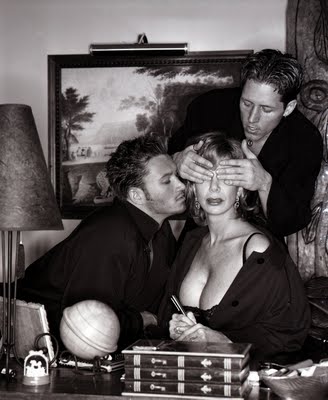
I tried to imagine some sort of scenario involving the two young men and J.M. but my failure was based both on shock; I had never done this sort of thing before, and my desire to make the woman look her best. Baring her breasts and whatever else she may have wanted to expose was something I didn’t think was a good idea. I failed because I was much too conservative and naïve. Looking back at these pictures I see a potential that I squandered. J.M. was having some fun (the boys were having fun, too) and wanted it on film but I was too dense to understand this. I may have injected some humour but most of it was unintended. Whatever J.M. wanted me to photograph it was not pornography.
Looking at the pictures now they seem almost silly, particularly when compared to the images that my 11 year-old granddaughter is capable of finding in the internet. She has seen just about every nude I have I taken and she has a mature adult approach to what I have shot in my past.
But as propriety and manners erode and as TV programs, films and standard on line content get racier and racier, the border between what is perceived as sexy to what is pornographic becomes that much more muddled. When I am asked what I consider pornography to be I always answer, “I vowed never to shoot babies, weddings and pornography. I have avoided the first two and tried on the third. Every time I try, I realize that to shoot pornography one must park one’s good taste. But good taste always prevails and my would-be pornography atempts descend to the realm of sexy or, as you see here, silly. I have long ago given up in punching people in the nose when they tell me, “Alex your nudes are tasteful.” Perhaps it is not too late to change what could well be my epitaph, "He was indeed tasteful".
Vanesa, The Dark Lady From Belorusse
Thursday, August 06, 2009

She was born in 1911, like Ginger Rogers and Jean Harlow, but she didn't have their platinum look: she was the dark lady from Belorusse.
The Dark Lady From Belorusse, Jerome Charyn
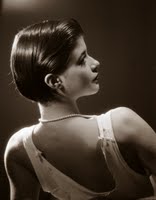
Swimming & Not Drowning
Wednesday, August 05, 2009

Not too long ago I received an unusual invitation from a renowned local designer to help in a workshop that was to address the declining esprit de corps of the arts staff of one of our city’s best design institute/college. I attended some of the talks and these dispirited professor/artists spoke of classes that had students that spanned ages from 19 to over 50. “How do you weigh, the perhaps, mediocre portfolio of an older student when you consider what could be their contribution in maturity and having lived?" said one professor. They spoke of students who were not interested in drawing, painting or life drawing classes. They wanted to skip all that “manual stuff”. They wanted to do what they believed was the future of art and design, the computer. These professors had so much bureaucratic stuff to do, and forms to fill out that the act of teaching was almost curtailed. I knew of one art teacher who was suffering the effects of artistic revisionism. “I am not allowed to stress the skills and stature of Picasso, the artist, because he ill-treated the women of his life.”
Not being part of an arts institution I was at a loss of words as to what I could possibly contribute to help the people who were facing me. But something suddenly popped into my head and I asked, “How many of you have some sort of personal project that you are currently working on? How many of you who are photographers are taking pictures? How many of you who paint are painting?” The raised hand count was sparse. I was perhaps rude or even cruel in then saying, “Unless you have a personal project how can you possibly inspire your students to learn?”
As my photographic profession fades into irrelevance and I face students at local photography schools I feel a bit of that depression and stress of those professors I write about above. I tell my wife, “How can I teach someone to swim when I am drowning?”

A few days ago my friend Abraham Rogatnick placed in my hands a pristine Leica IIIf. It does not have a coupled rangefinder so it is a pain to focus. But it has that solid heft of a camera that was made when some cameras could also be and were works of art. My Leica (I like the ring of that!) is not going to be a museum piece. I am going to use it. I might load it with Kodak Tri-X or Plus-X. But I will use it.
If I have been low in spirits all these months it has to do with the fact that I have not been practicing what I preach. I have always had a personal project until now. I have not taken pictures for fun except the few, the very few, of my granddaughters. This has to change.
As an example many years ago I had a show of women in bathtubs. This was a personal project. I was hired to photograph architect Bing Thom for Western Living. It was about the Canada Pavilion he had designed for the Expo 92 in Seville, Spain. I asked Thom, “Have you designed any houses in Vancouver with a swimming pool?” His affirmative answer prompted me to photograph him floating in a pool. My picture was so well received that in that year I won a Western Magazine Award for the best editorial photograph. This is ample proof that the personal project nurtures inspiration to perform in an unusual and satisfying manner for those projects that may seem to some as being humdrum.
I believe as the commercial photographer that I am that if I have a personal project that I do for no purpose except to please myself I will soon find a way of doing it again for very good money. Art and commercial photography can live side by side, harmoniously.
The Dark Side of NIna Gouveia
Tuesday, August 04, 2009
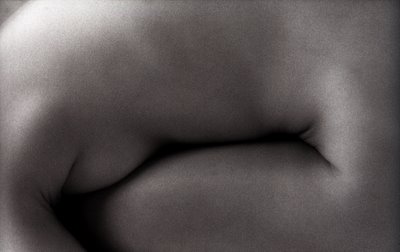
It’s not only painters that have pigment periods (blue, red, etc) or brightness and darkness periods. Additionally those of us who printed (and I still print) b+w photographs in a darkroom had our high contrast periods and our low, milky skin ones. When I look back at some of my vintage prints I am amazed at how dark or how light they are.

It seems that accuracy was not important as much as drama. Here are some pictures of that wonderful subject of mine who had to go to Spain and now I can only look at the many negatives that I have of her that never saw the light of day. A scanner and a lonely evening combine perfectly for the task of finding gems I did not notice the first or second time around. Here are some scanned really dark. I am pleased with their rich darkness. I will have to go to my studio and print these dark on good photographic paper.


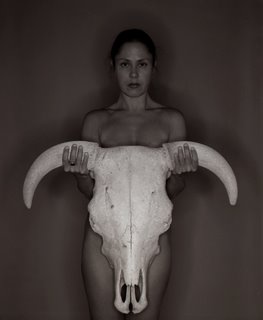
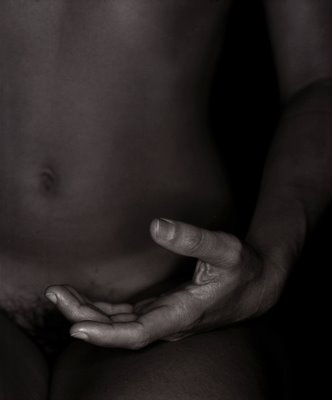
Puckish By Lunchtime
Monday, August 03, 2009
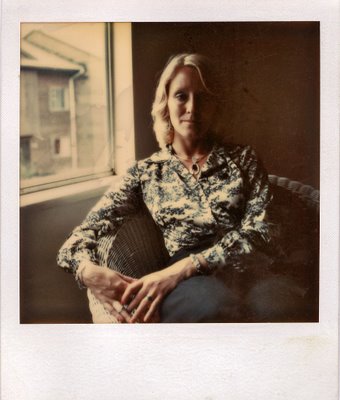
I spent my day in a most extraordinary but ambivalent way. One moment I felt I was in a soaring situation and the next I was in a no solution, no way out fit of depression. I spent my day with two persons (not together). One told me once, a few days back, “I am dying,” while the other has often told me, “I don’t want to live.”
It was quite a few years ago that on my way to my first hosta convention in Columbus, Ohio I visited my aunt Dorothy in Toronto. I wrote about her statement that she didn’t want to go on here. I have been thinking about her recently as I deal with my 85 year-old cousin and godmother in Buenos Aires who is excited to be alive and enjoys every spoken DVD book I send her by the mail.
I live with what I consider to be minor chronic pains and I wonder if I too, when that pain is racked up in intensity, will want to stop living. I will only know when I am there.

Today I read to my friend from The Nowel Coward Diaries which has post-it notes to passages that interested me the first time I read this lovely book. I was suddenly moved to optimism and glee when I read him:
…Cole and I had a long and cosy [ Noel Coward’s spelling] talk about death the other evening, sitting up here watching the dark come and the fireflies to appear. He is so sensible. We discussed what would happen if I died and what would happen if he died, and came to the sensible conclusion that there was nothing to be done. We should have to get on with life until our turn came. I said, ‘After all, the day had to go on and breakfast had to be eaten,’ and he replied that if I died he might find it a little difficult to eat breakfast but would probably be puckish by lunch-time…
Sunday, 19 November,1961, The Noel Coward Diaries
I came to the conclusion today that it is not pain ( since I am not suffering enough of it I could be completely wrong here) but the prospect of losing one’s independence and self-sufficiency that initiates a desire to vacate in some way a present existence.
As a boy my black Raleigh was indestructible. I could repair flat tires and when the chain fell off I knew how to fix it. A frequent hosing of the bike and an application of 3 & 1 Oil made the bike seem to run twice as fast. I did not need anybody. In Mexico around 1970 I learned to do most of the tuneups and repairs to our VW Beetle. I would remove the gasoline tank once a year and wash its interior with paint thinner. Mexican gasoline had lots of water and gunk. Fuel lines would stop up frequently if I did not perform this task.
If my wife’s Audi would suddenly stop in the middle of a bridge or street I would not even begin to know where to look to start it again. The complexification of our machines has made us ever more dependent on others. If my computer crashes I might turn it off and then turn it on as a last ditch attempt to repair it. After that I will be lost and will have to take the unit to someone who might know.
Tomorrow I teach from 9 to 4. Rosemary will be leaving the hospital late morning. There is no way I can cancel my classes in short notice nor can I find anybody to substitute me in class. This means that the only person who can take Rosemary home is my son-in-law Bruce who happily does not work tomorrow.
I left my wife with a sad look on her face tonight and I told her, “I have you and you have me. We have nobody else." At one time that was good. We were young and healthy. There was always a way. Now we have lost that independence, that self-sufficiency. We are going to have to learn to depend on others.
It is somewhere when that dependency becomes almost total that one’s will to live erodes.
One Plum, One SUV & Rosemary Nags Me To Water The Garden
Sunday, August 02, 2009

Yesterday Saturday my daughter Ale and her nieces Rebecca and Lauren went to Baja California for two weeks. Rosemary was supposed to go but she had an unscheduled and violent appointment with an SUV at a city corner on Friday noon. She was an innocent pedestrian at the wrong place.
A shattered left ankle must be an example of good luck within all the bad luck that has prevented Rosemary of having our two granddaughters almost all for herself for 14 days.
The operation (this morning) was successful and her doctor predicts that she might be walking (in an orthopedic boot) in about four weeks.
While I always think that Rosemary is most serious she has shown some humour. It seems that she chatted with her ambulance attendant on the short trip to VGH. She asked him, “You did put on the siren for me, didn’t you?” At emergency she was depressed to find out that her clothes had been all cut out. It took me a couple of days to retrieve her sandals, “They were $200 sandals you know?”
As soon as Rosemary found out about the fire in Lillooet she forgot about her ankle and her pain. “There is that Ramirez guitar we bought for Ale in Madrid. It’s going to burn.” Meanwhile my positively philosophical daughter Ale told me on Skype from San Jose del Cabo, “My cats are in Cache Creek and I am here, what could be safer? Besides the Ramirez guitar is in my old room in your house in the closet.”
So now Rosemary is concerned she will not be around to nag our little girls to only speak in Spanish. She is worried about being able to walk for the wedding of her nephew in Brockville at the end of August. And she is of course happily nagging me to water the garden in the allowed hours of 7 to 10 on Sunday nights which is precisely what I am doing right now.
Rosemary is sad that I am not going to have the vacation without her during the next two weeks. I could not manage to explain that while I am sorry she is not having fun in the 42 degree weather of Baja I am very happy to have her here all to myself. Or at least by tomorrow afternoon when she will probably checking out of the hospital.
I returned from the hospital and went into the refrigerator and found a large plum that Rosemary bought for me. I have written many times here about that wonderful poem by William Carlos Williams.
This Is Just To Say
I have eaten
the plums
that were in
the icebox
and which
you were probably
saving
for breakfast
Forgive me
they were delicious
so sweet
and so cold
I ate that single plum and I reminded myself that Rebecca knows that poem by heart. For two weeks I will have my Rosemary and then, when the girls return, we might just celebrate that we are all alive and that we can enjoy some cold plums from the icebox.
With Paul Grant Gone Arts Coverage Wanes At The CBC
Saturday, August 01, 2009
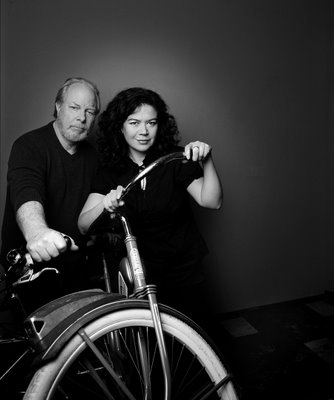
Last Friday was CBC Hot Air host and arts reporter Paul Grant’s last day at the CBC. Like many other luminaries with long years of experience at “The Corporation” he “took the package” or “was made an offer he could not refuse”. What few know is that people who take these packages are not replaced and the jobs they performed are eliminated. In Paul Grant’s case this is not quite true as his long stint as host to the popular jazz program Hot Air has him being replaced by the charming Margaret Gallagher. Both are seen here in the photograph. I wrote about them here and here. I am sure that Gallagher will do a beautiful job. But it is the other Grant position that has me losing even more enthusiasm for my CBC Radio. Grant was a most frequent contributor to a local Arts Report. Often his arts report had him sparring nicely with On the Coast Host Stephen Quinn.
What Grant’s retirement means is that those arts reports are history until someone at the CBC with imagination and initiative (two qualities about to become extinct at our de-facto National Radio Network) can figure out a different moniker for Grant’s former job.
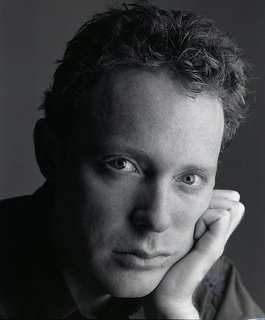
Gone with Grant was his enthusiasm and wonder for anything related to the arts. Some years ago when I was a member of the board of the Pacific Baroque Orchestra, ticket sales for a concert involving Toronto countertenor Matthew White, right, were not moving. I called up Grant on a Wednesday (the concert was that Friday and Saturday) and asked him, “How would you like to interview a grown man who sings with a falsetto?” Grant’s answer was a short, “I would.” He then asked me, “Do you want to bring him here?” I did just that and to avoid booking problems, Grant interviewed White on a bench outside the CBC. The story ran on the radio next day and the Pacific Baroque Orchestra’s concert sold out!
There are those who say that photography and radio are not compatible. One day I called up Grant and told him, “I am having a one man show in a few weeks. The photographs are nudes of a beautiful woman of Finnish extraction holding different leaves from my hosta garden. Are you interested?” Grant came to my studio, witnessed a session and then interviewed my subject who was not wearing anything. I would say that photography, with Grant’s kind of radio, are most compatible!
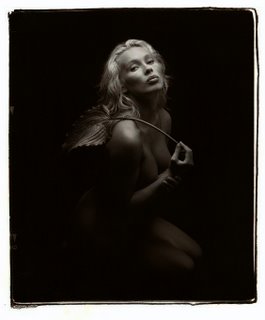
Without Grant the diminishing quantity and quality of arts coverage and reporting has reached a dangerous level that puts many of our local arts organizations at the risk of disappearing almost as quickly as the quality content of our de-facto National Radio Network.
While I am no spokesperson for the arts I am sure that the arts organizations of this town would probably share my gratitude to you for a job well done. As for Gallagher, I can only request, ever so respectfully, that you dedicate a Hot Air program soon to as many versions your CBC jazz vaults might have of Gerry Mulligan playing My Funny Valentine.
Addendum:
Lucky for Paul, but I wonder if he'll turn up freelancing anywhere. He's not so old yet (I'd guess same age as me). But I will miss pitching him stories - I always enjoyed finding an angle for him that would work on Arts Report. The other loss is that many of Paul's Vancouver stories also ran nationally (including the one of me giving Paul a tour of PAL when we opened the building). Speaking of visual stories on radio - when artist clients touring back east emailed me about hearing me excitedly showing off my new washer and dryer.
Ellie O'Day
More PAL






